Research on Aerodynamic Characteristics of Trans-Media Vehicles Entering and Exiting the Water in Still Water and Wave Environments
Abstract
1. Introduction
2. Airframe Design Scheme for Trans-Media Aircraft
2.1. Layout and Principle of Airframe Propulsion System
2.2. Internal Structure Design of Trans-Media Aircraft
2.2.1. Conduit Shape Design
2.2.2. Frame Structure Design
3. Based on OpenFOAM Numerical Calculation Theory
3.1. Numerical Water/Gas Two-Phase Flow Mathematical Model
3.2. Trans-Medium Aircraft Multi-Medium Spanning Moving Mesh Technology
3.3. Numerical Wave Making
4. Numerical Prediction of Aircraft Entering and Exiting the Water
4.1. Mesh Independence Test
4.2. Mesh Generation Verification Analysis
4.3. Research on the Water-Entry and -Exit Characteristics of the Aircraft in the Static Water State
4.3.1. Water-Entry Characteristics at Different Angles
4.3.2. Water-Entry Characteristics at Different Heights
4.3.3. Aircraft Water-Exit Characteristics
4.4. Research on Water-Entry Characteristics in Wave State
4.4.1. Fixed Wave Intensity (the Height of the Water Column Is a Fixed Value)
4.4.2. Fixed Water-Entry Angle (Changes Wave Intensity)
5. Conclusions
- (1)
- At the beginning of the water entry, the wet water area of the vehicle increases rapidly, and if the speed of entry is relatively large, there will be a relatively stable vacuole separation line; the water is separated from the surface of the body, and the entry vacuole begins to form.
- (2)
- After the vehicle enters the water for a period of time, the vacuole will be connected to the atmosphere; air continues to fill the rear space of the object entering the water, and the vacuole continues to increase, which is partly air and partly steam. As the vacuole increases, the buoyancy force on the vehicle increases.
- (3)
- The next step in the development of the incoming vacuole is the closure of the vacuole, where the air on the surface of the water no longer enters the vacuole. When the forces that determine vacuole closure (hydrostatic pressure, dynamic pressure of air flowing in the vacuole, and surface tension) dominate, the vacuole begins to narrow, neck, and finally close. When the bubble closes, the waters moving inward collide together and produce upward and downward water jets.
- (4)
- After the bubble is closed, as the object continues to move, the bubble, due to the water hostage effect, gradually reduces to completely disappear. After the disappearance of the air bubble, the object in the water begins to enter the full wetting motion; at this time, the object is far from the free surface of the water, and the free surface of the flow of the impact can be disregarded. The flow is unbounded.
Author Contributions
Funding
Data Availability Statement
Acknowledgments
Conflicts of Interest
References
- Ma, Z.; Chen, D.; Li, G.; Jing, X.; Xiao, S. Configuration Design and Trans-Media Control Status of the Hybrid Aerial Underwater Vehicles. Appl. Sci. 2022, 12, 765. [Google Scholar] [CrossRef]
- Zhang, X.; Huang, J.; Huang, Y.; Huang, K.; Yang, L.; Han, Y.; Wang, L.; Liu, H.; Luo, J.; Li, J. Intelligent amphibious ground-aerial vehicles: State of the art technology for future transportation. IEEE Trans. Intell. Veh. 2022, 1–19. [Google Scholar] [CrossRef]
- Bi, Y.; Lu, D.; Zeng, Z.; Lian, L. Dynamics, and control of hybrid aerial underwater vehicle subject to disturbances. Ocean Eng. 2022, 250, 110933. [Google Scholar] [CrossRef]
- Shi, Y.; Pan, G.; Yim, S.C.; Yan, G.; Zhang, D. Numerical investigation of hydroelastic water-entry impact dynamics of AUVs. J. Fluids Struct. 2019, 91, 102760. [Google Scholar] [CrossRef]
- Zhou, D.-H.; Shi, H.-H.; Jia, H.-X. Characteristics of the multiphase flow field with super-cavitation induced by successively fired projectiles under-water and cross-medium. J. Mech. Sci. Technol. 2022, 36, 247–258. [Google Scholar] [CrossRef]
- Shi, Y.; Pan, G.; Yan, G.-X.; Yim, S.C.; Jiang, J. Numerical study on the cavity characteristics and impact loads of AUV water entry. Appl. Ocean Res. 2019, 89, 44–58. [Google Scholar] [CrossRef]
- Huang, L.; Ren, K.; Li, M.; Tuković, Ž.; Cardiff, P.; Thomas, G. Fluid-structure interaction of a large ice sheet in waves. Ocean Eng. 2019, 182, 102–111. [Google Scholar] [CrossRef]
- Shi, F.; Xin, J.; Jin, Q. A Cartesian grid based multiphase flow model for water impact of an arbitrary complex body. Int. J. Multiph. Flow 2019, 110, 132–147. [Google Scholar] [CrossRef]
- Wu, Q.; Ni, B.; Bai, X.; Cui, B.; Sun, S. Experimental study on large deformation of free surface during water exit of a sphere. Ocean Eng. 2017, 140, 369–376. [Google Scholar] [CrossRef]
- Peng, B.; Zhou, C. An approach of dynamic mesh adaptation for simulating 3-dimensional unsteady moving-immersed-boundary flows. Int. J. Numer. Methods Fluids 2018, 87, 180–201. [Google Scholar] [CrossRef]
- Xin, J.; Shi, F.; Fan, S.; Jin, Q.; Chang, X. Parametric studies on the water impact of one and twin free-falling wedges by a Cartesian grid multiphase flow model. Ocean Eng. 2022, 249, 110854. [Google Scholar] [CrossRef]
- Osher, S.; Sethian, J.A. Fronts propagating with curvature-dependent speed: Algorithms based on Hamilton-Jacobi formulations. J. Comput. Phys. 1988, 79, 12–49. [Google Scholar] [CrossRef]
- Osher, S.; Fedkiw, R.P. Level set methods: An overview and some recent results. J. Comput. Phys. 2001, 169, 463–502. [Google Scholar] [CrossRef]
- Chang, Y.-C.; Hou, T.; Merriman, B.; Osher, S. A level set formulation of Eulerian interface capturing methods for incompressible fluid flows. J. Comput. Phys. 1996, 124, 449–464. [Google Scholar] [CrossRef]
- Sussman, M.; Fatemi, E.; Smereka, P.; Osher, S. An improved level set method for incompressible two-phase flows. Comput. Fluids 1998, 27, 663–680. [Google Scholar] [CrossRef]
- Yang, C.; Mao, Z.-S. An improved level set approach to the simulation of drop and bubble motion. Chin. J. Chem. Eng. Engl. Version 2002, 10, 263–272. [Google Scholar]
- Marchandise, E.; Remacle, J.-F. A stabilized finite element method using a discontinuous level set approach for solving two phase incompressible flows. J. Comput. Phys. 2006, 219, 780–800. [Google Scholar] [CrossRef]
- Sethian, J.A.; Smereka, P. Level set methods for fluid interfaces. Annu. Rev. Fluid Mech. 2003, 35, 341–372. [Google Scholar] [CrossRef]
- Olsson, E.; Kreiss, G. A conservative level set method for two phase flow. J. Comput. Phys. 2005, 210, 225–246. [Google Scholar] [CrossRef]
- Hirt, C.W.; Nichols, B.D. Volume of fluid (VOF) method for the dynamics of free boundaries. J. Comput. Phys. 1981, 39, 201–225. [Google Scholar] [CrossRef]
- Rider, W.J.; Kothe, D.B. Reconstructing volume tracking. J. Comput. Phys. 1998, 141, 112–152. [Google Scholar] [CrossRef]
- Harvie, D.J.; Fletcher, D.F. A new volume of fluid advection algorithm: The stream scheme. J. Comput. Phys. 2000, 162, 1–32. [Google Scholar] [CrossRef]
- Cifani, P.; Michalek, W.; Priems, G.; Kuerten, J.G.; van der Geld, C.; Geurts, B.J. A comparison between the surface compression method and an interface reconstruction method for the VOF approach. Comput. Fluids 2016, 136, 421–435. [Google Scholar] [CrossRef]
- Ashgriz, N.; Poo, J. FLAIR: Flux line-segment model for advection and interface reconstruction. J. Comput. Phys. 1991, 93, 449–468. [Google Scholar] [CrossRef]
- Youngs, D.L. Time-dependent multi-material flow with large fluid distortion. In Numerical Methods in Fluid Dynamics; Academic Press: Cambridge, MA, USA, 1982. [Google Scholar]
- Yang, A.-S.; Yang, J.-C.; Hong, M.-C. Droplet ejection study of a Picojet printhead. J. Micromechanics Microengineering 2005, 16, 180. [Google Scholar] [CrossRef]
- Meier, M.; Yadigaroglu, G.; Smith, B.L. A novel technique for including surface tension in PLIC-VOF methods. Eur. J. Mech. -B/Fluids 2002, 21, 61–73. [Google Scholar] [CrossRef]
- Sussman, M.; Puckett, E.G. A coupled level set and volume-of-fluid method for computing 3D and axisymmetric incompressible two-phase flows. J. Comput. Phys. 2000, 162, 301–337. [Google Scholar] [CrossRef]
- Lv, X.; Zou, Q.; Reeve, D. Numerical simulation of overflow at vertical weirs using a hybrid level set/VOF method. Adv. Water Resour. 2011, 34, 1320–1334. [Google Scholar] [CrossRef]
- Wang, Z.; Yang, J.; Koo, B.; Stern, F. A coupled level set and volume-of-fluid method for sharp interface simulation of plunging breaking waves. Int. J. Multiph. Flow 2009, 35, 227–246. [Google Scholar] [CrossRef]
- Liu, D.; Tang, W.; Wang, J.; Xue, H.; Wang, K. Modelling of liquid sloshing using CLSVOF method and very large eddy simulation. Ocean Eng. 2017, 129, 160–176. [Google Scholar] [CrossRef]
- Sun, D.; Tao, W. A coupled volume-of-fluid and level set (VOSET) method for computing incompressible two-phase flows. Int. J. Heat Mass Transf. 2010, 53, 645–655. [Google Scholar] [CrossRef]
- Zhao, L.; Shkarayev, S. Characterization of ducted contra-rotating propeller propulsions. Int. J. Micro Air Veh. 2019, 11, 1756829319837661. [Google Scholar] [CrossRef]
- Noh, W.F.; Woodward, P. SLIC (simple line interface calculation). In Proceedings of the Fifth International Conference on Numerical Methods in Fluid Dynamics, Twente University, Enschede, The Netherlands, 28 June–2 July 1976; pp. 330–340. [Google Scholar]
- Lopez, J.; Hernandez, J.; Gomez, P.; Faura, F. An improved PLIC-VOF method for tracking thin fluid structures in incompressible two-phase flows. J. Comput. Phys. 2005, 208, 51–74. [Google Scholar] [CrossRef]
- Roenby, J.; Larsen, B.E.; Bredmose, H.; Jasak, H. A new volume-of-fluid method in OpenFOAM. In Proceedings of the MARINE VI: Proceedings of the VI International Conference on Computational Methods in Marine Engineering, Nantes, France, 5–17 May 2017; pp. 266–277. [Google Scholar]
- Eymard, R.; Gallouët, T.; Herbin, R. Finite volume methods. Handb. Numer. Anal. 2000, 7, 713–1018. [Google Scholar]
- Weller, H. A Code Independent Notation for Finite Volume Algorithms; Technical Report TR/HGW/02; Nabla Ltd.: Port Louis, Mauritius, 2002. [Google Scholar]
- Dubief, Y.; Delcayre, F. On coherent-vortex identification in turbulence. J. Turbul. 2000, 1, N11. [Google Scholar] [CrossRef]
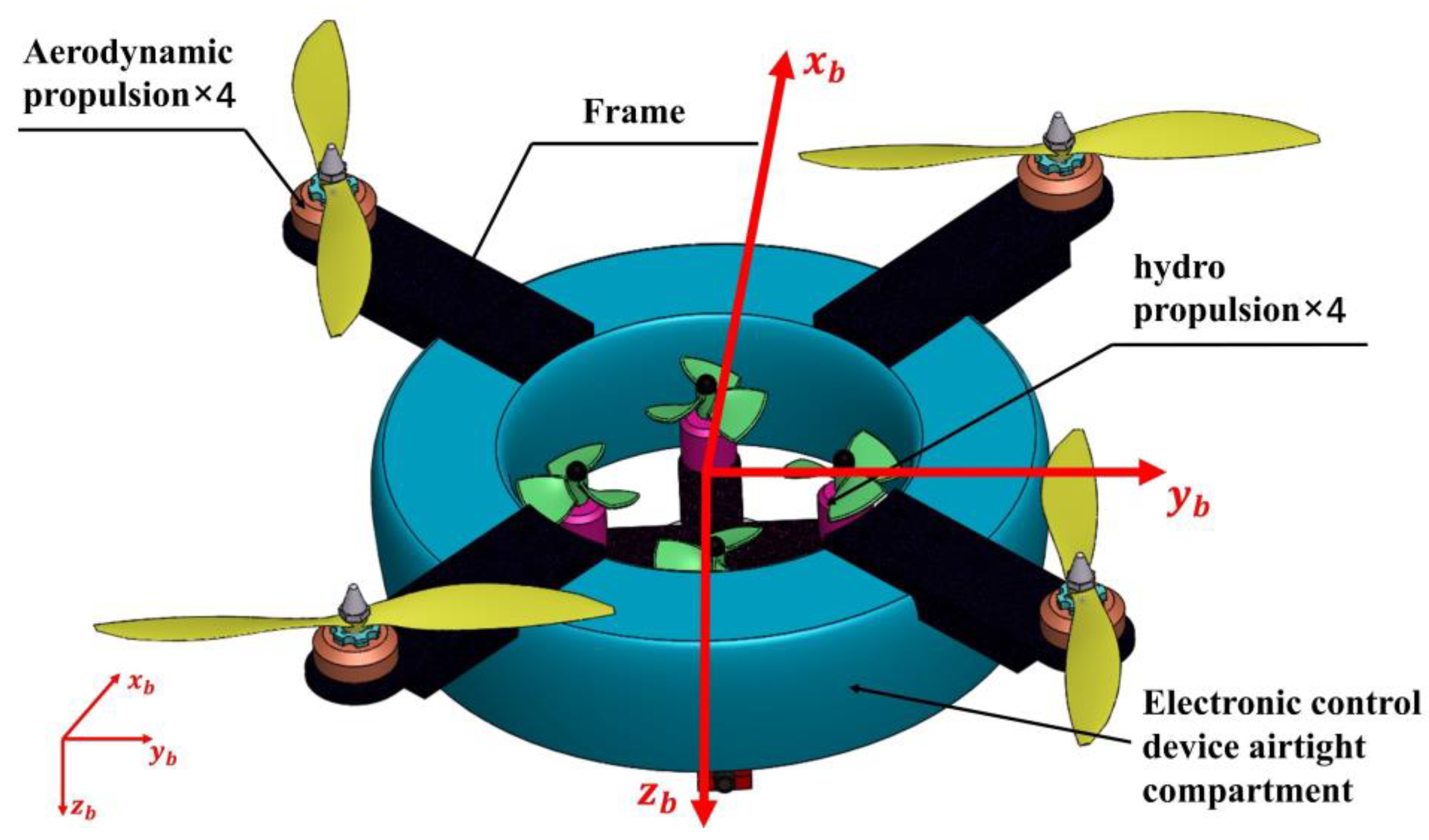
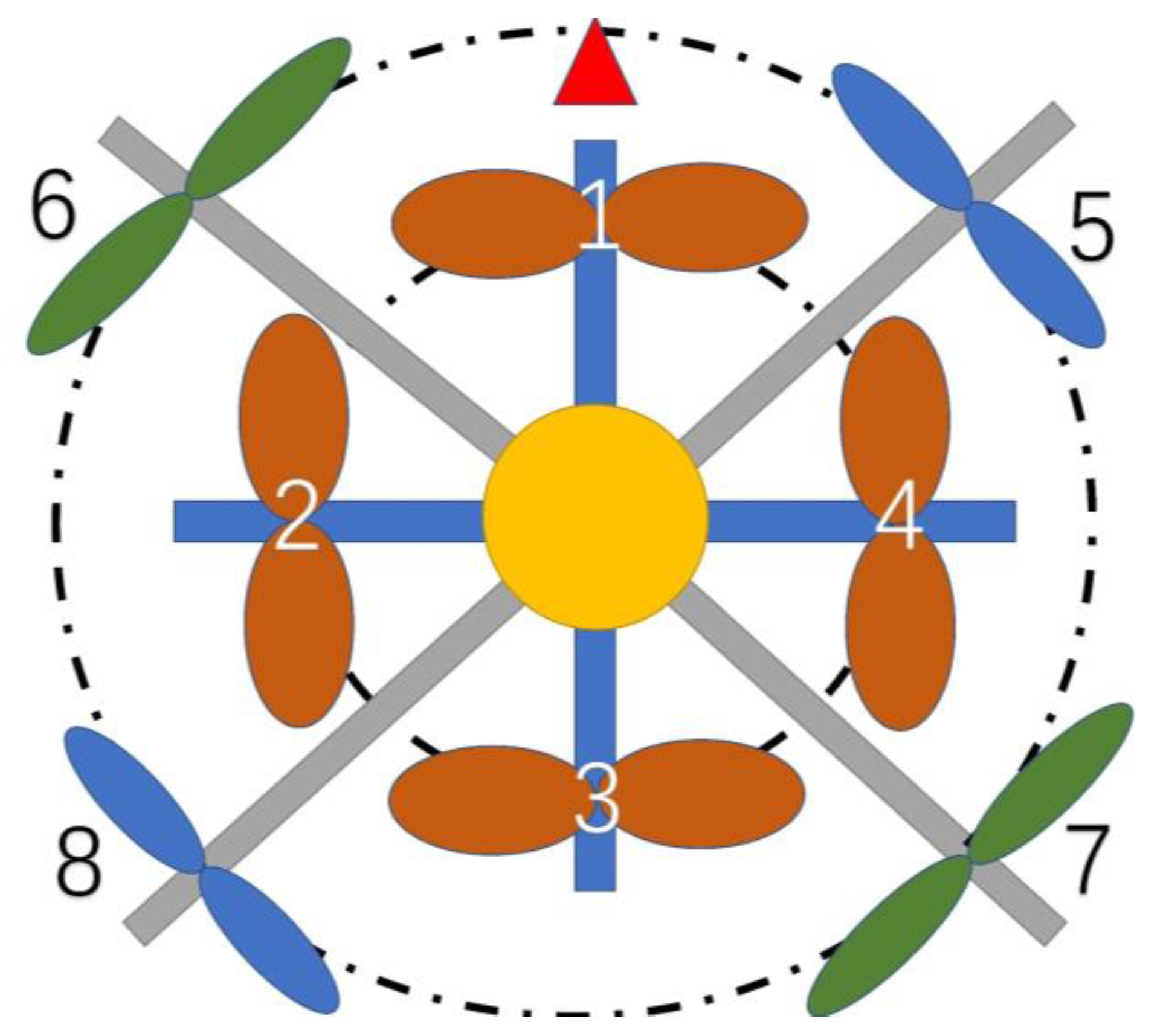
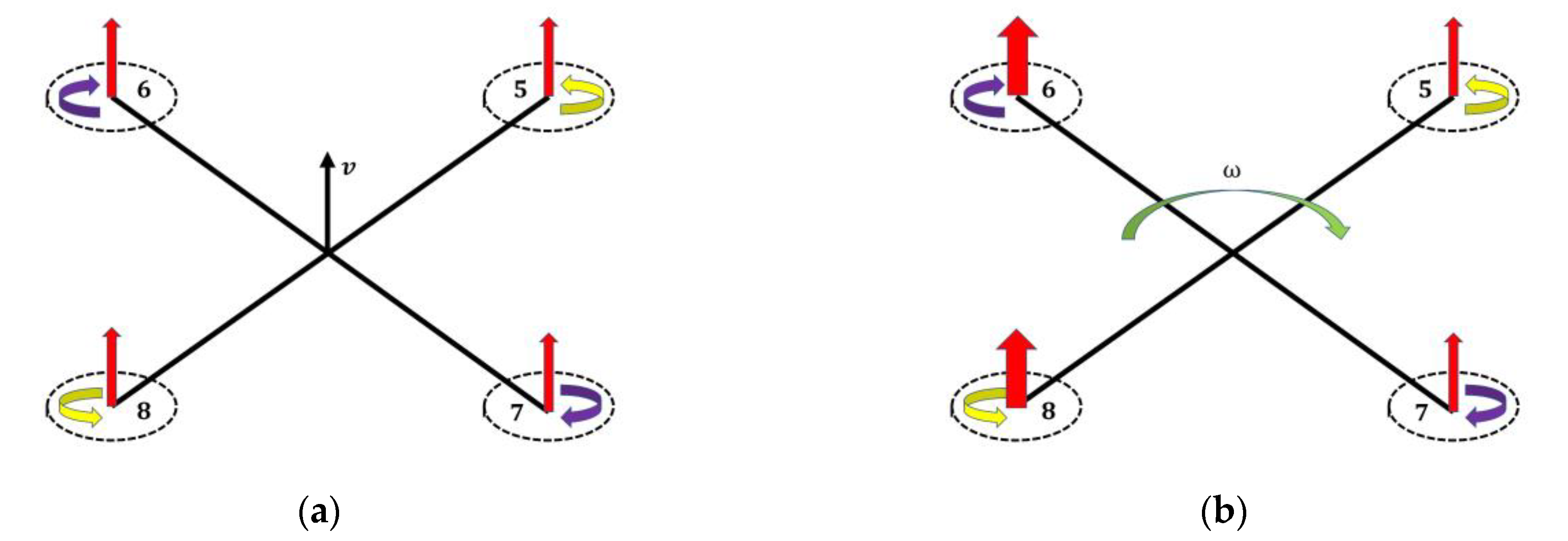

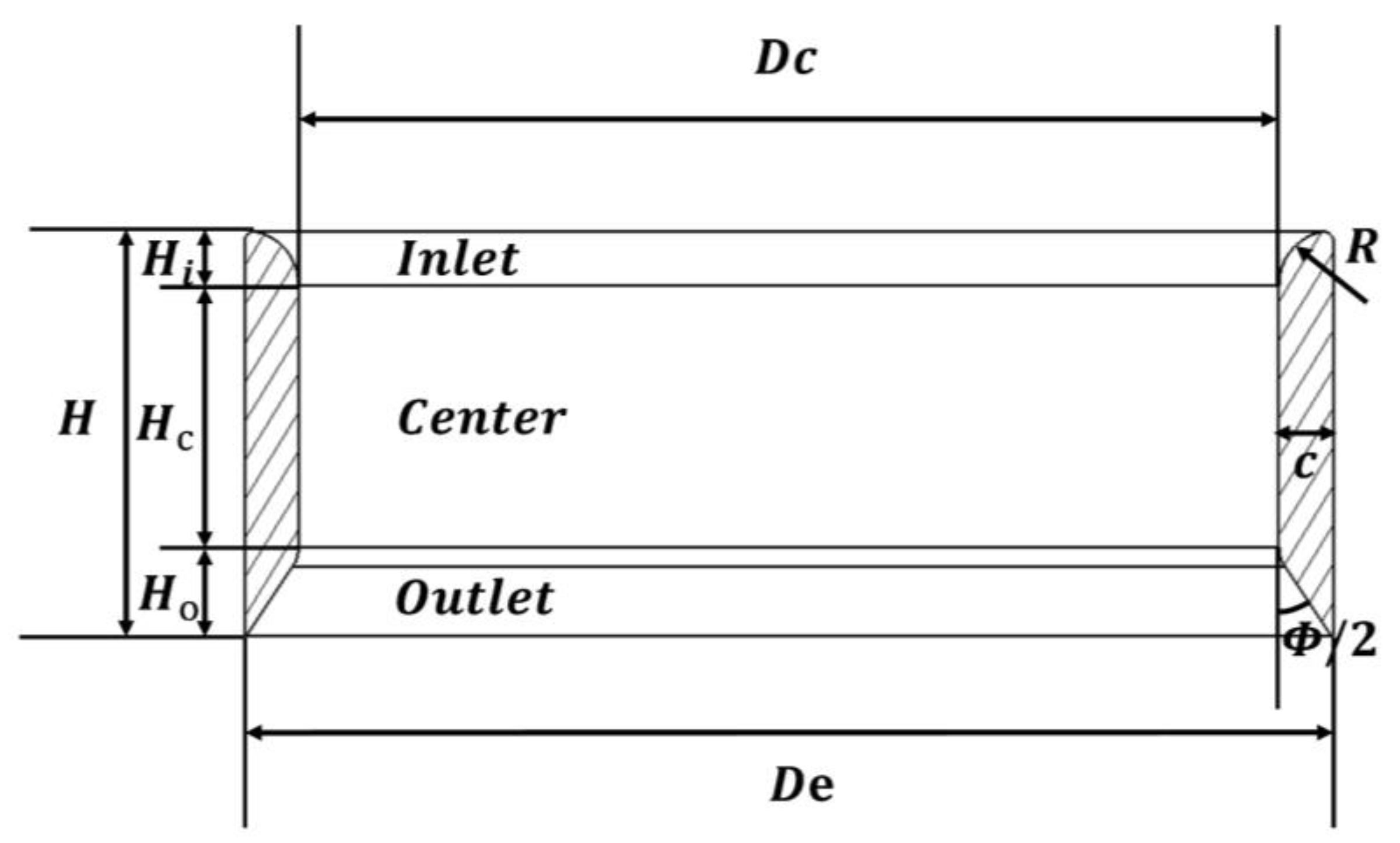
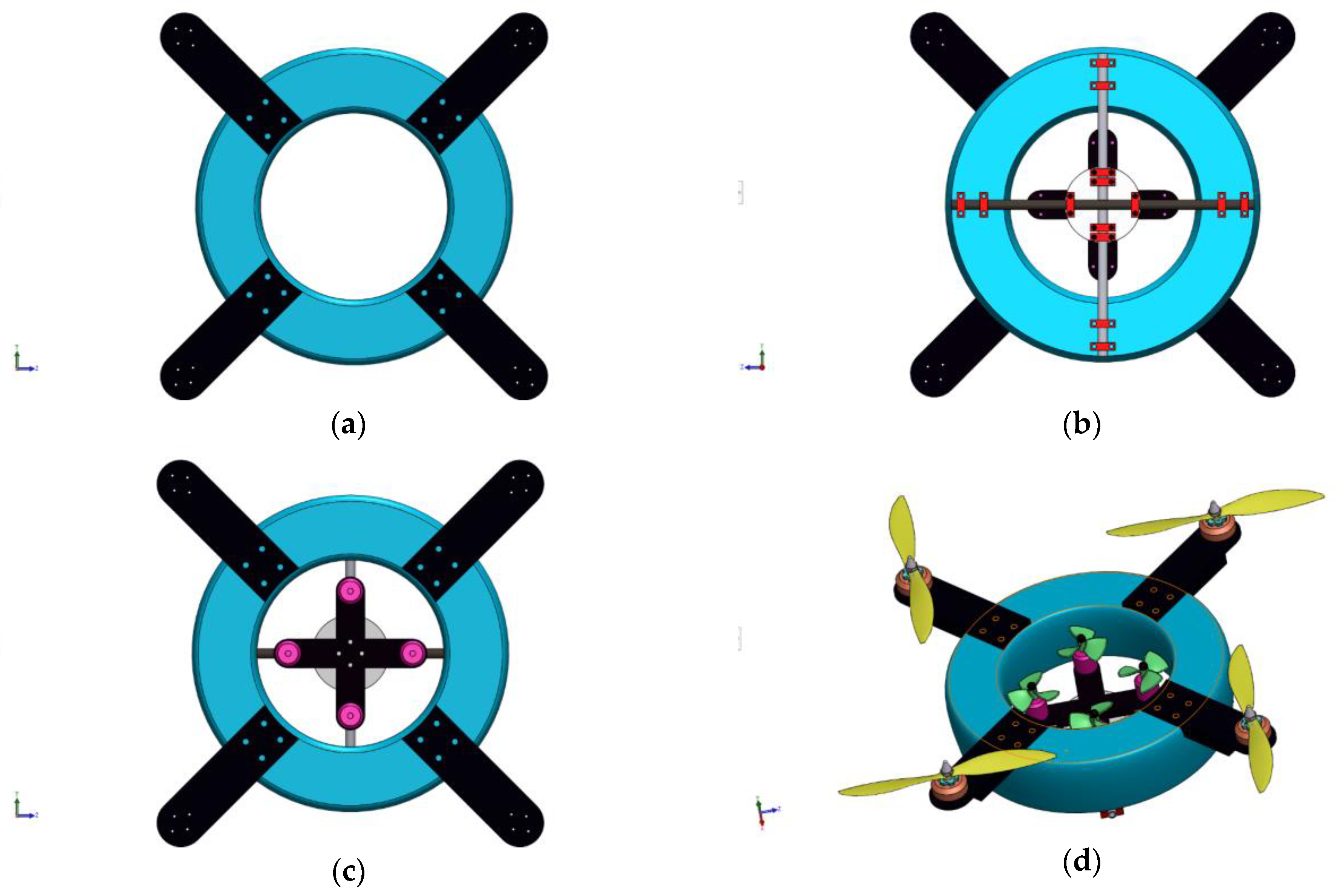


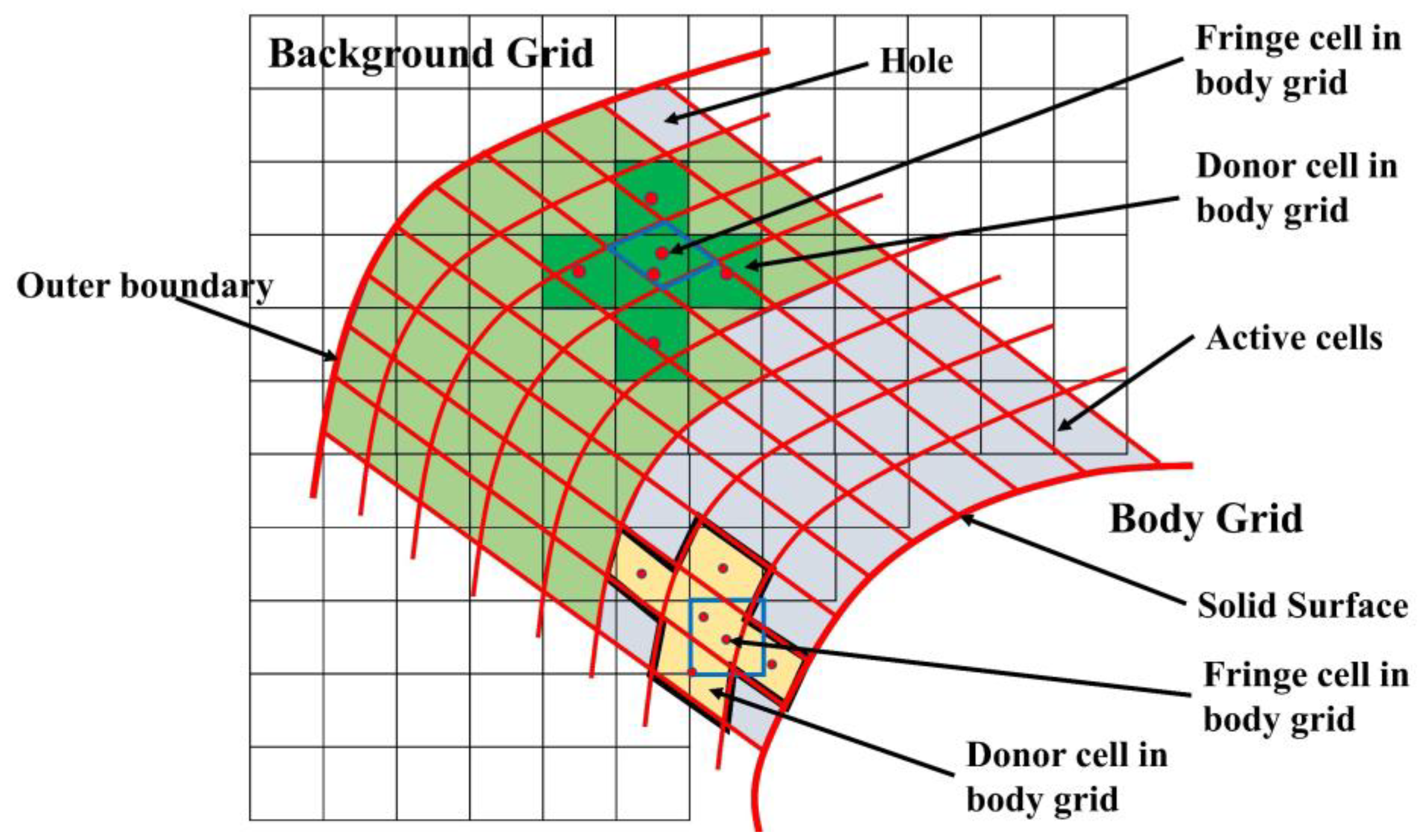

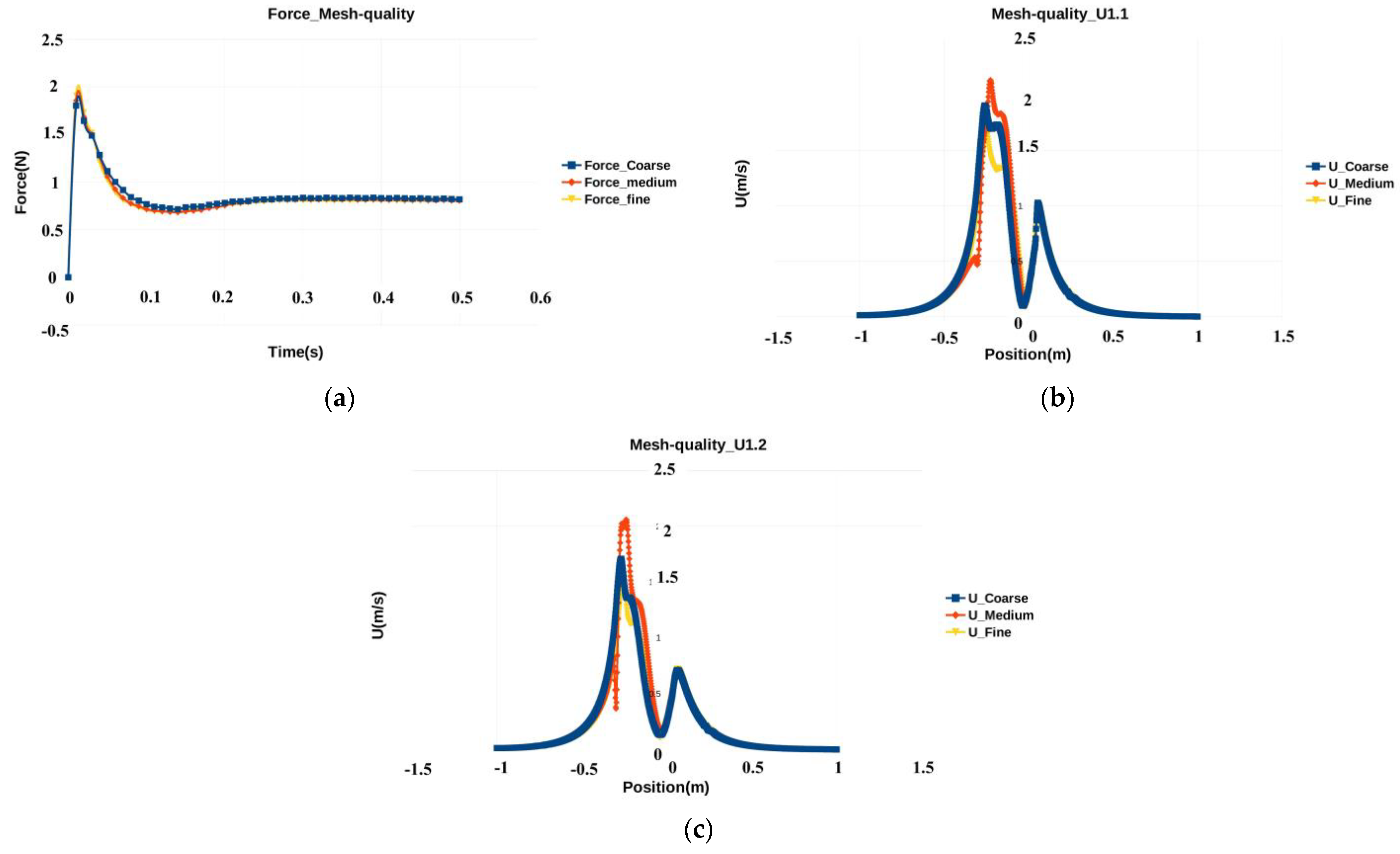
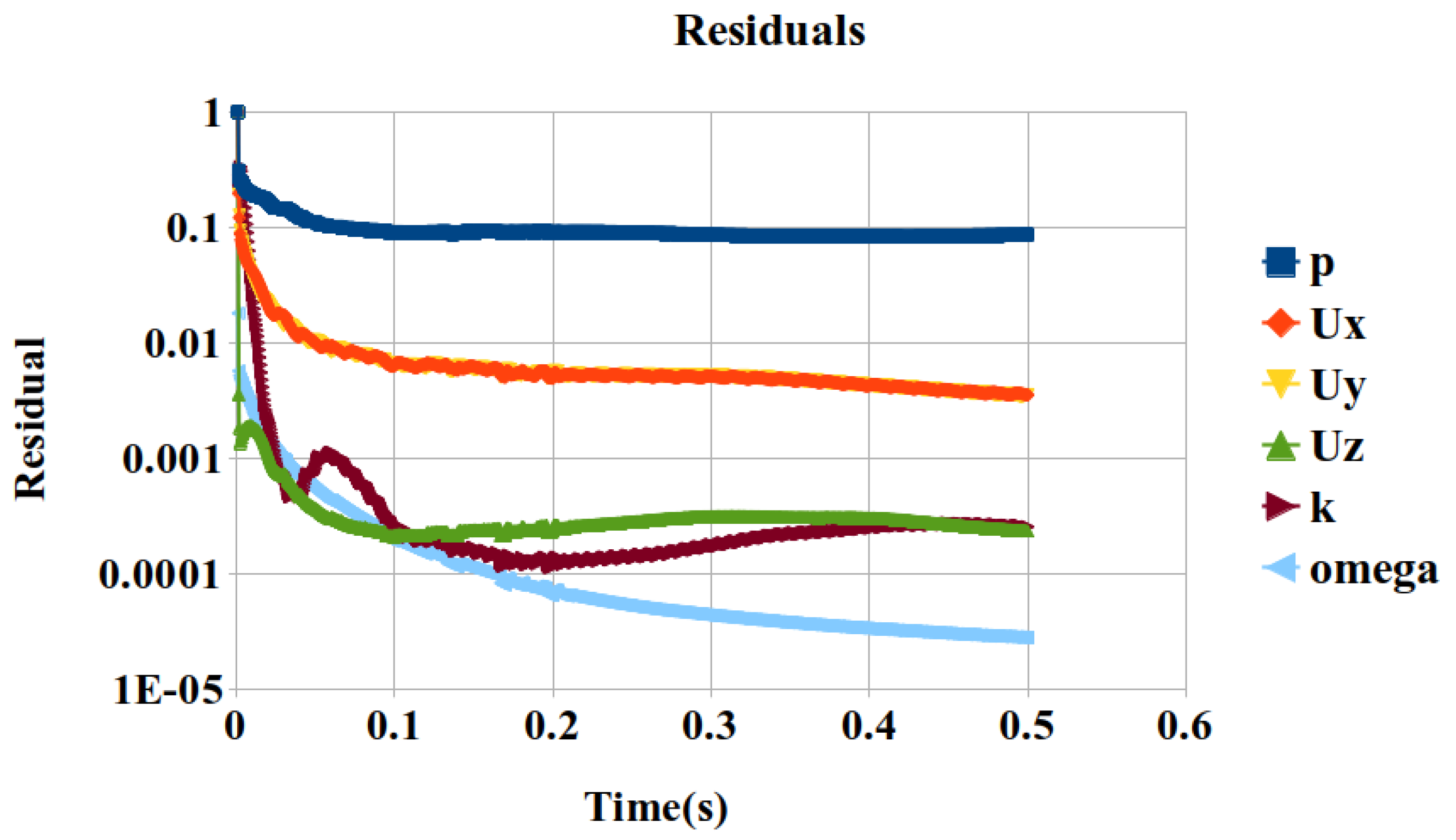
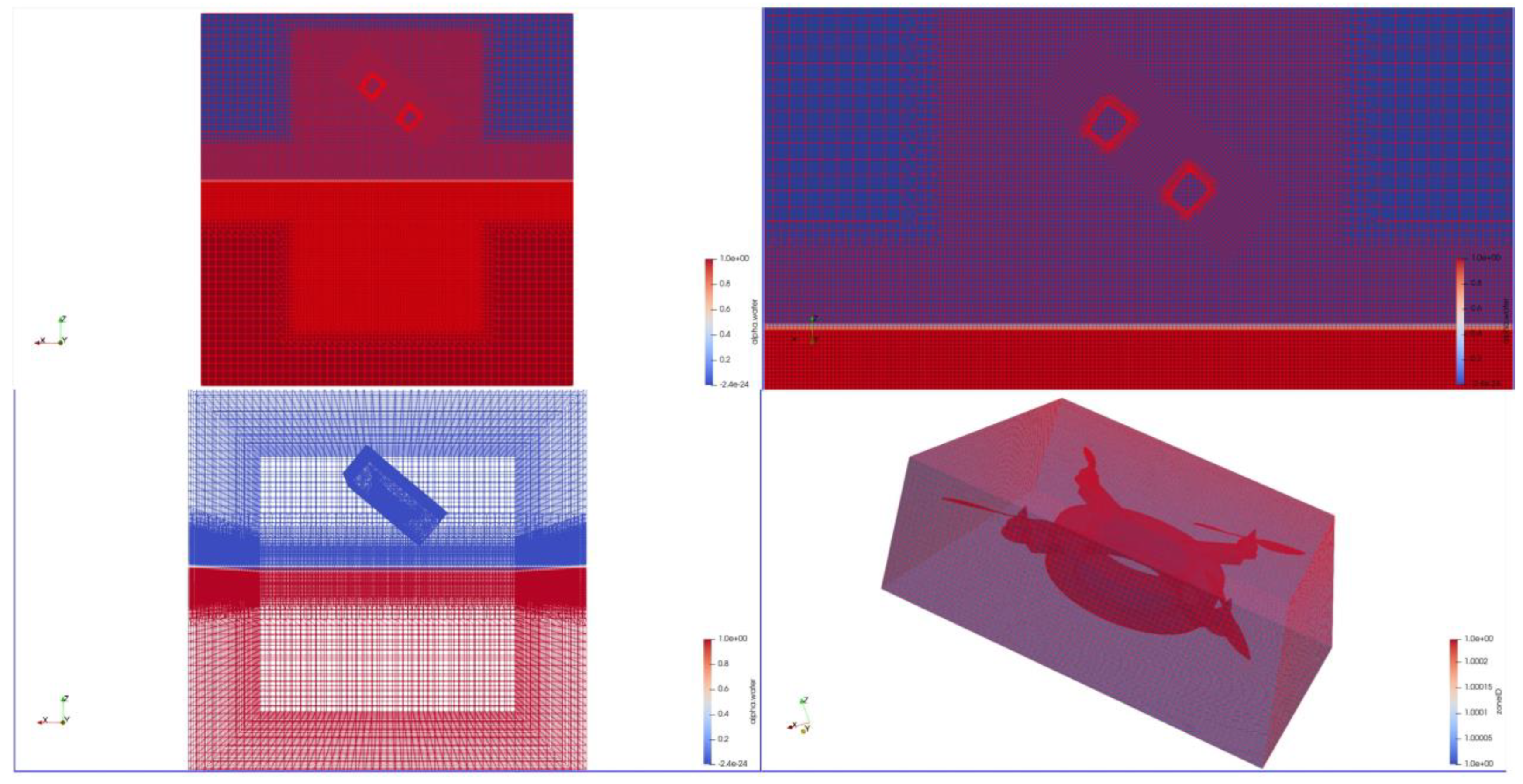
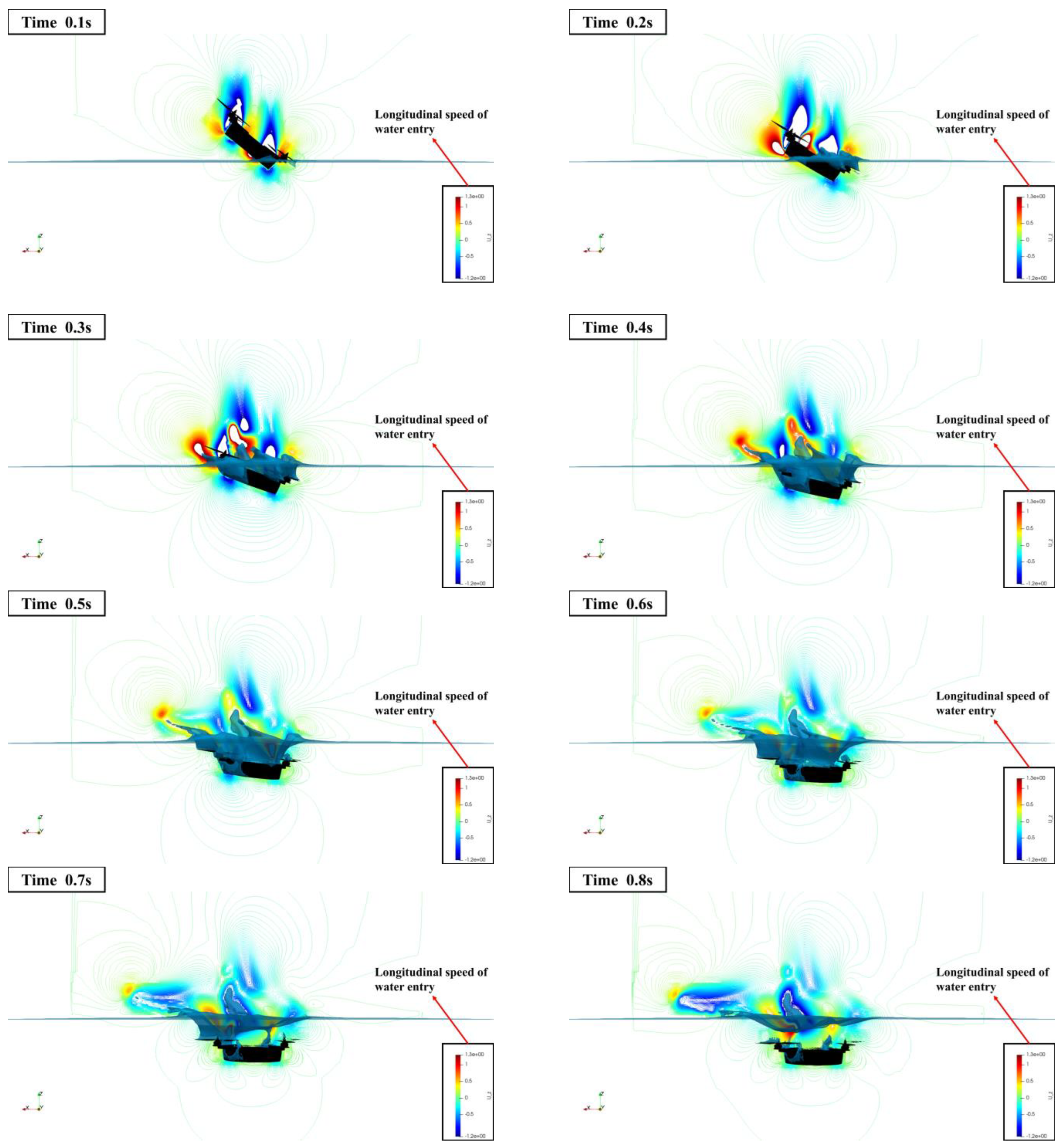
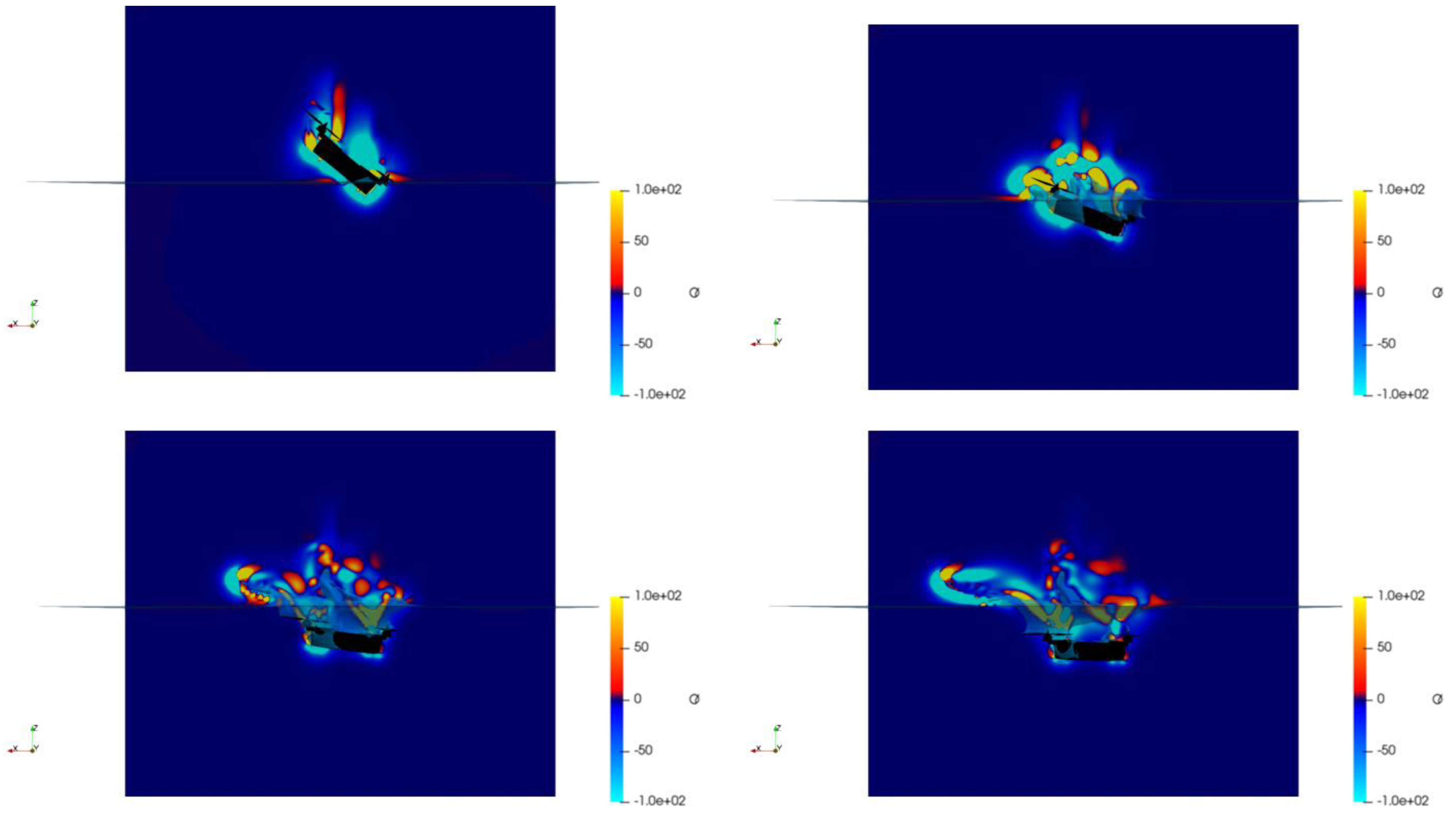




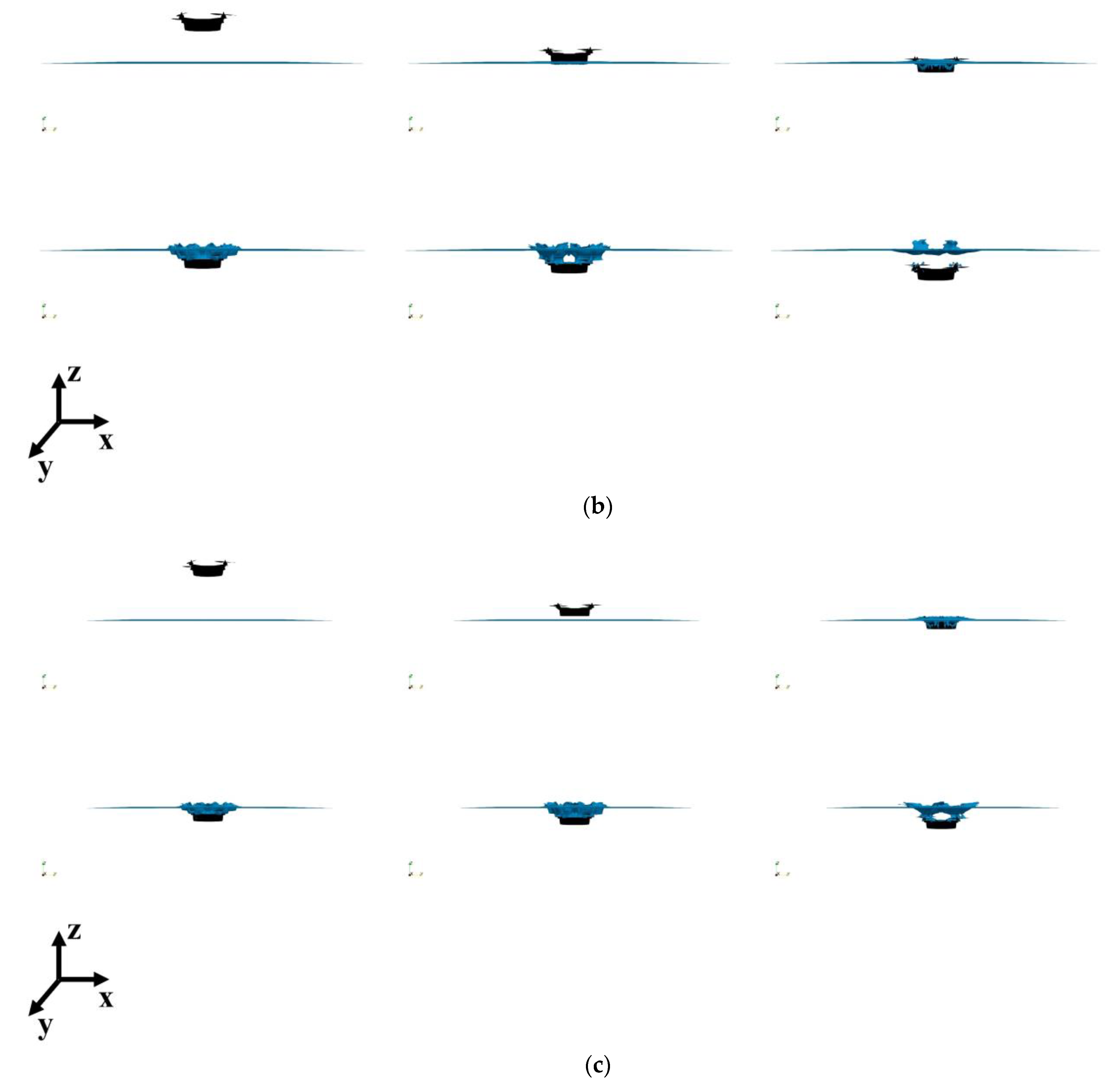
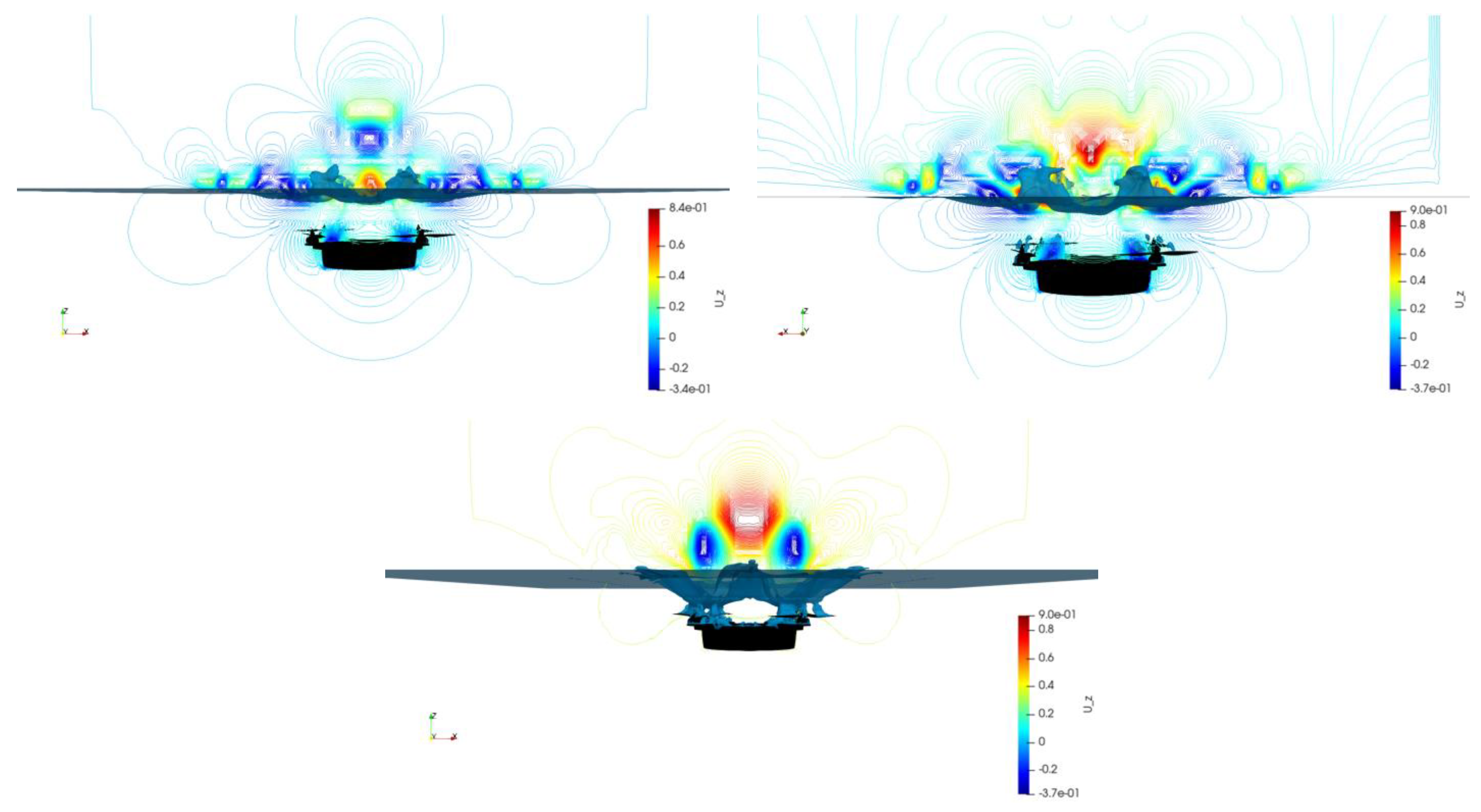

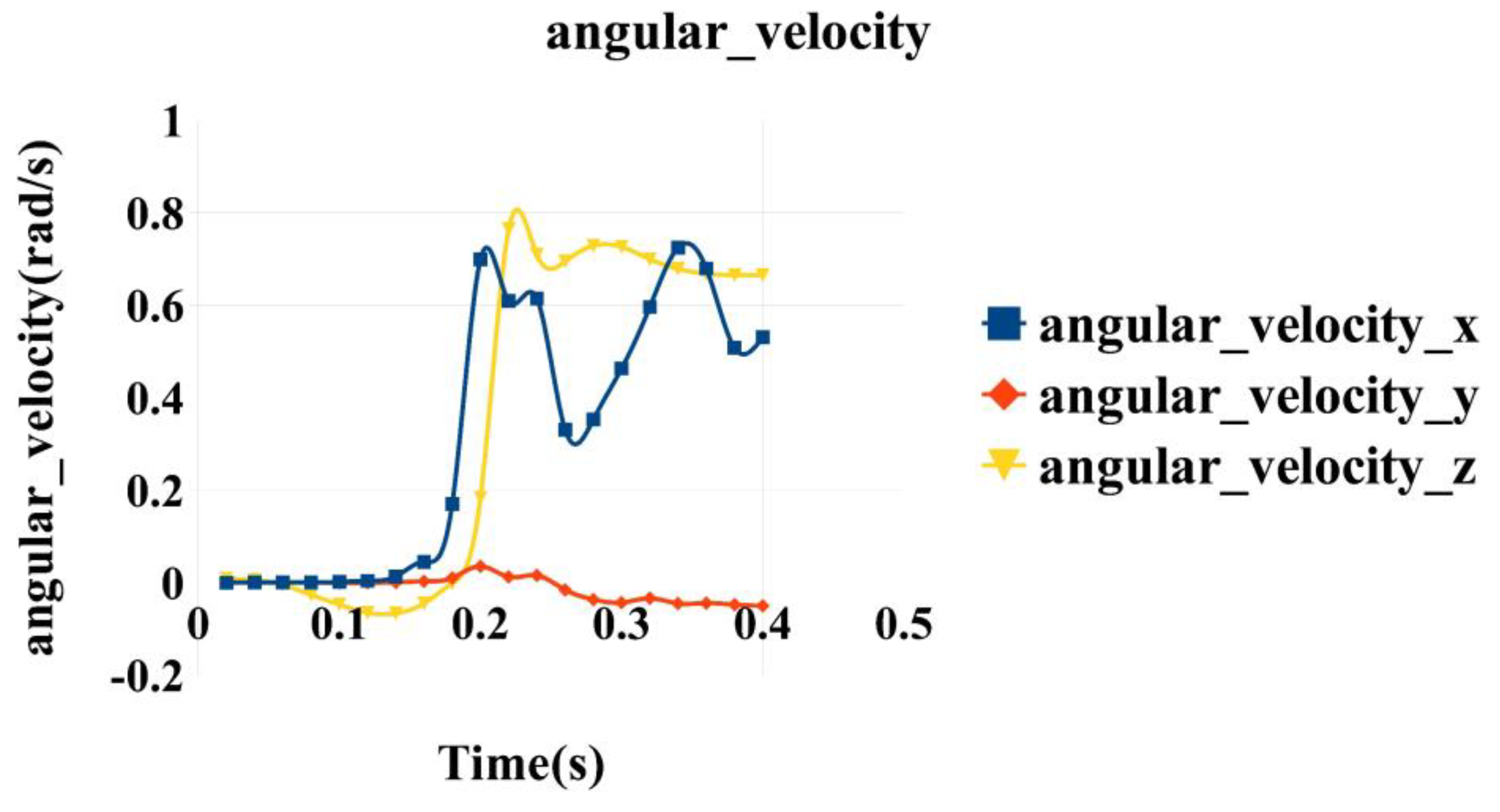

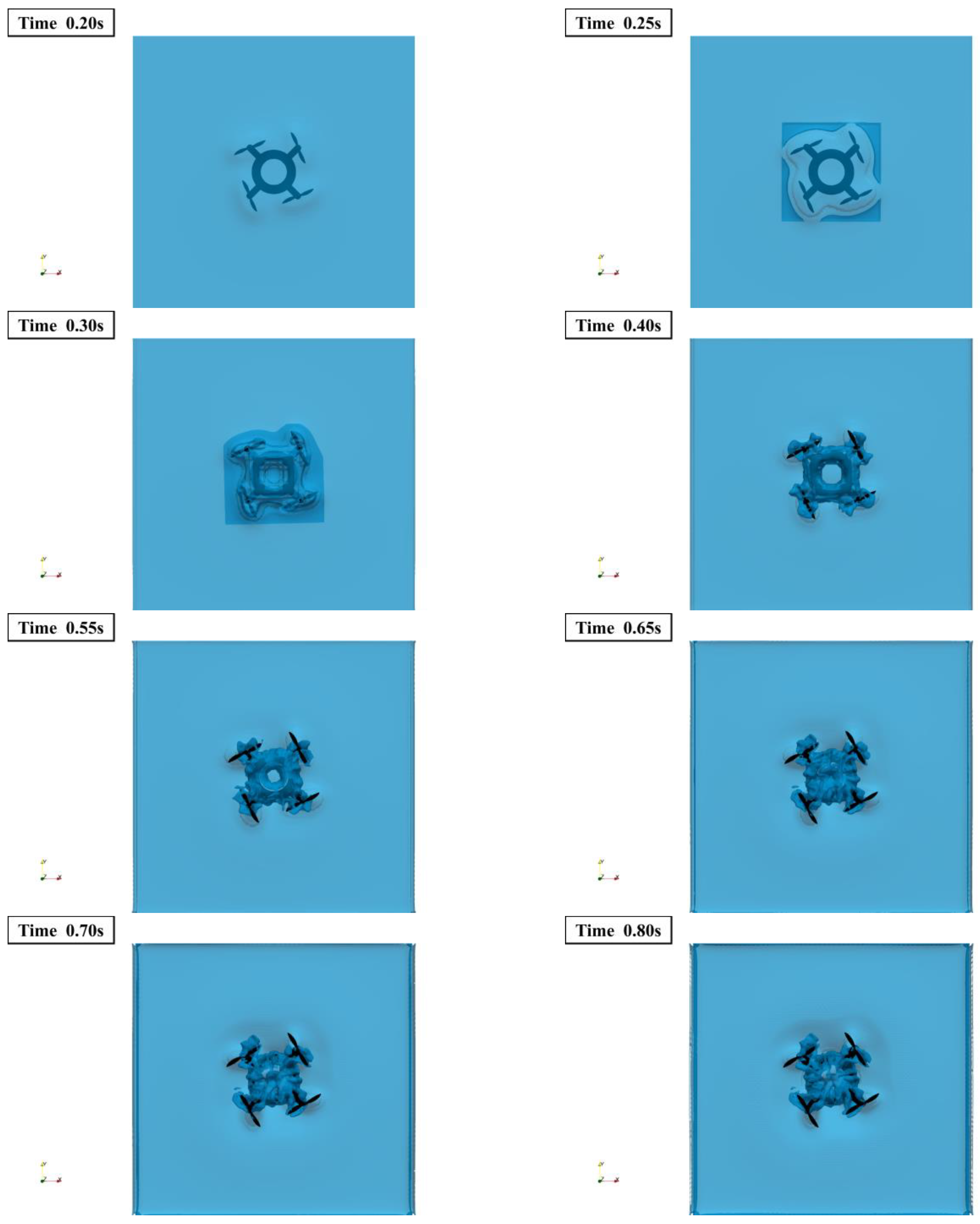
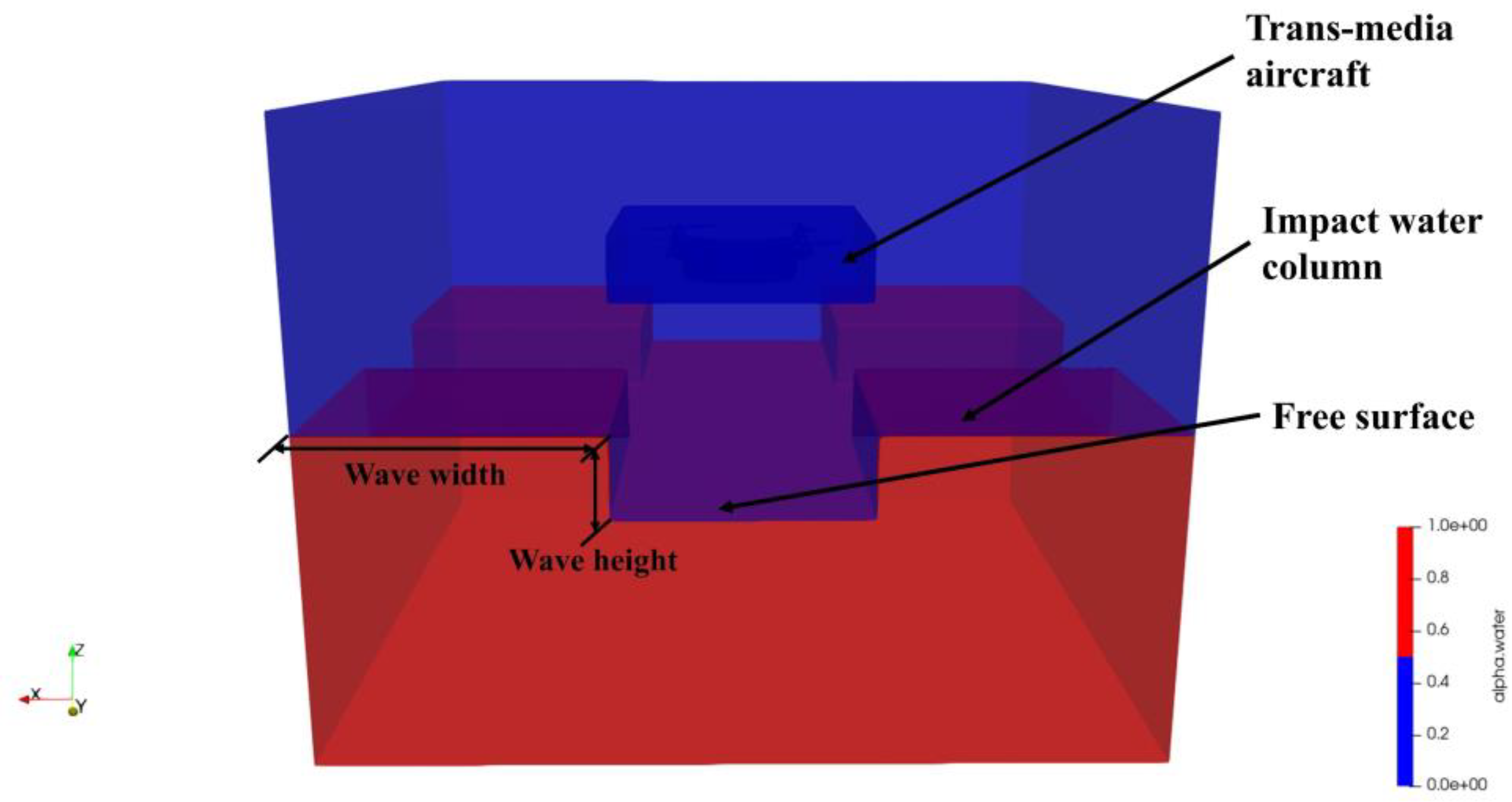

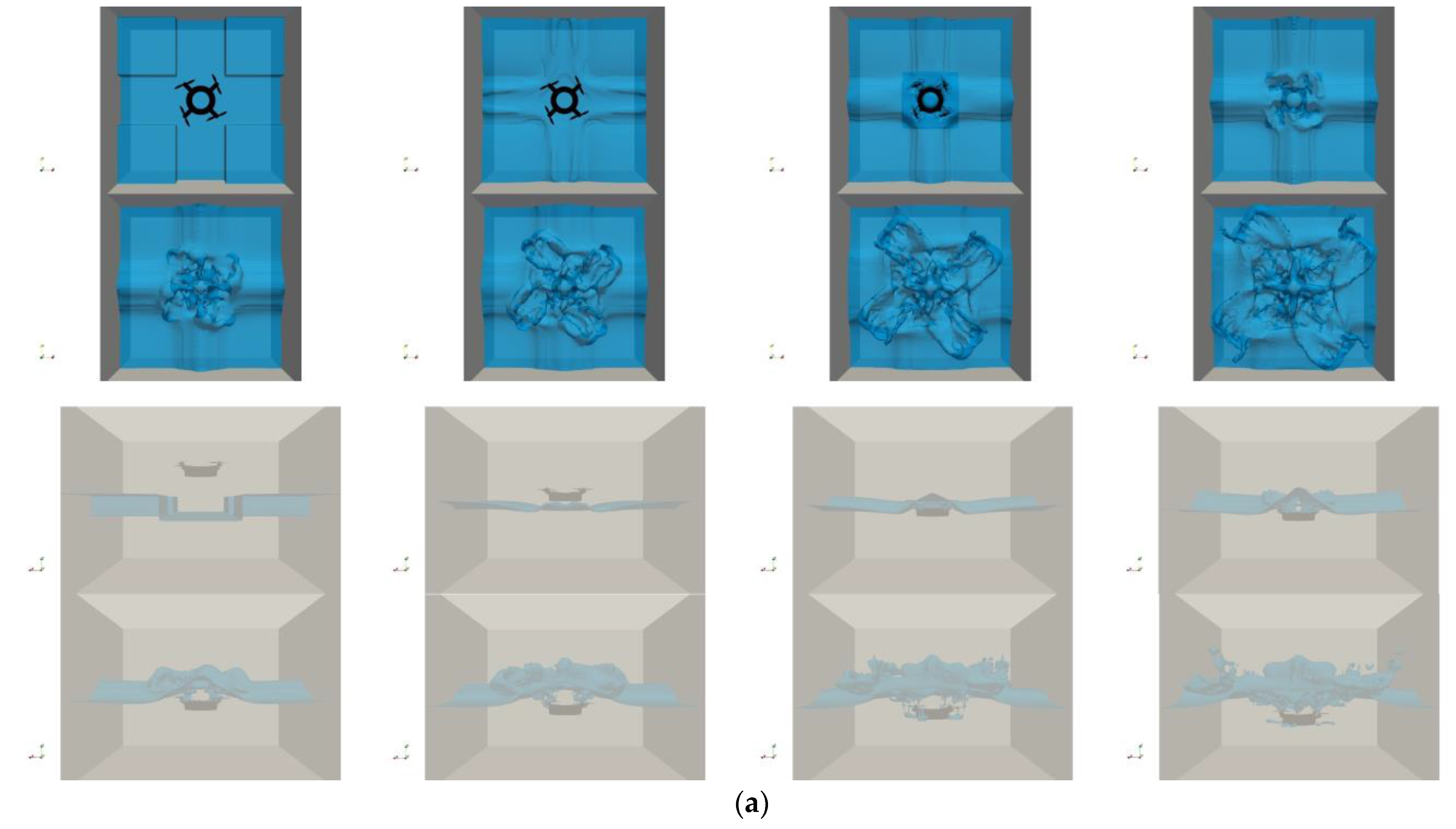
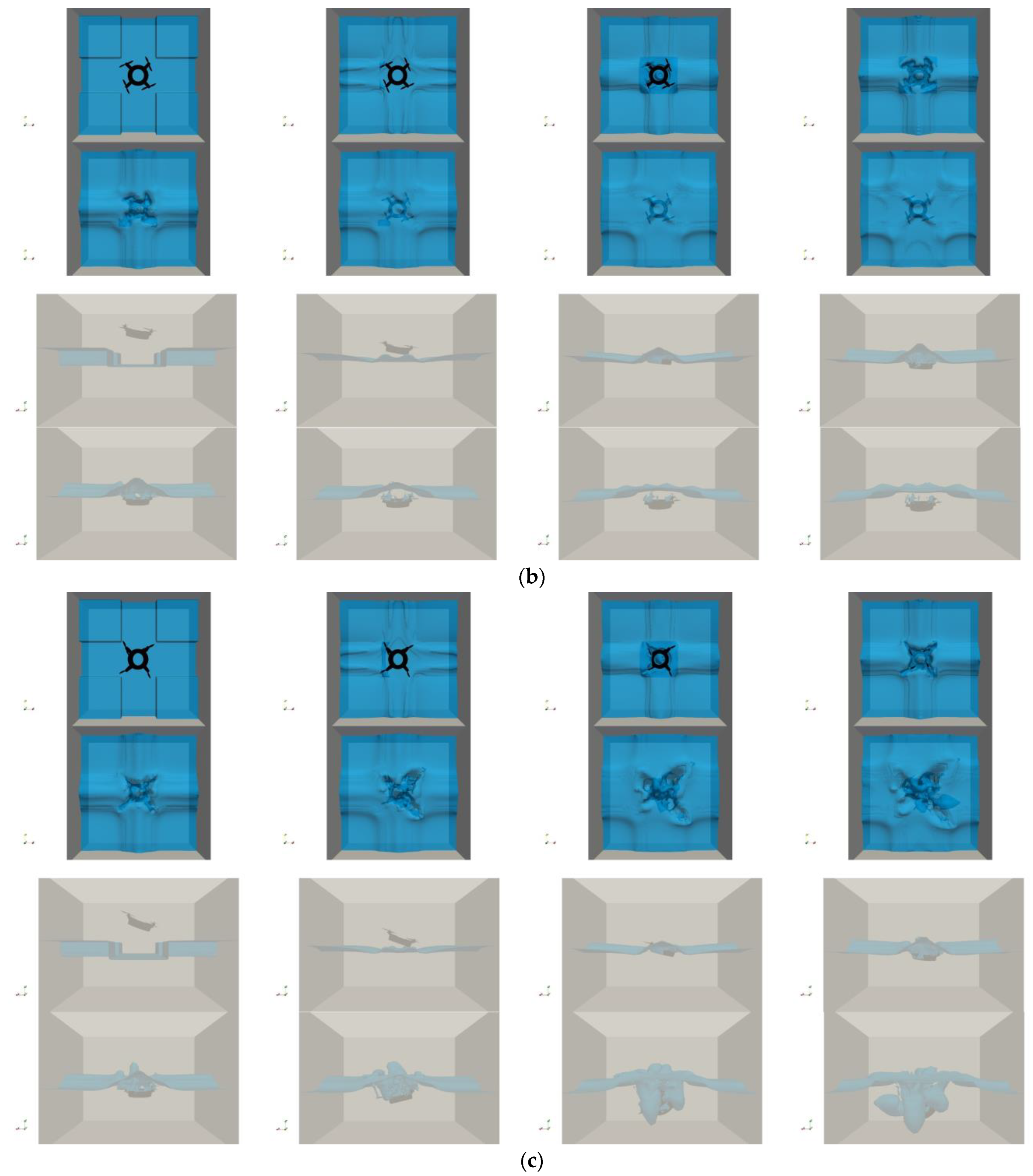
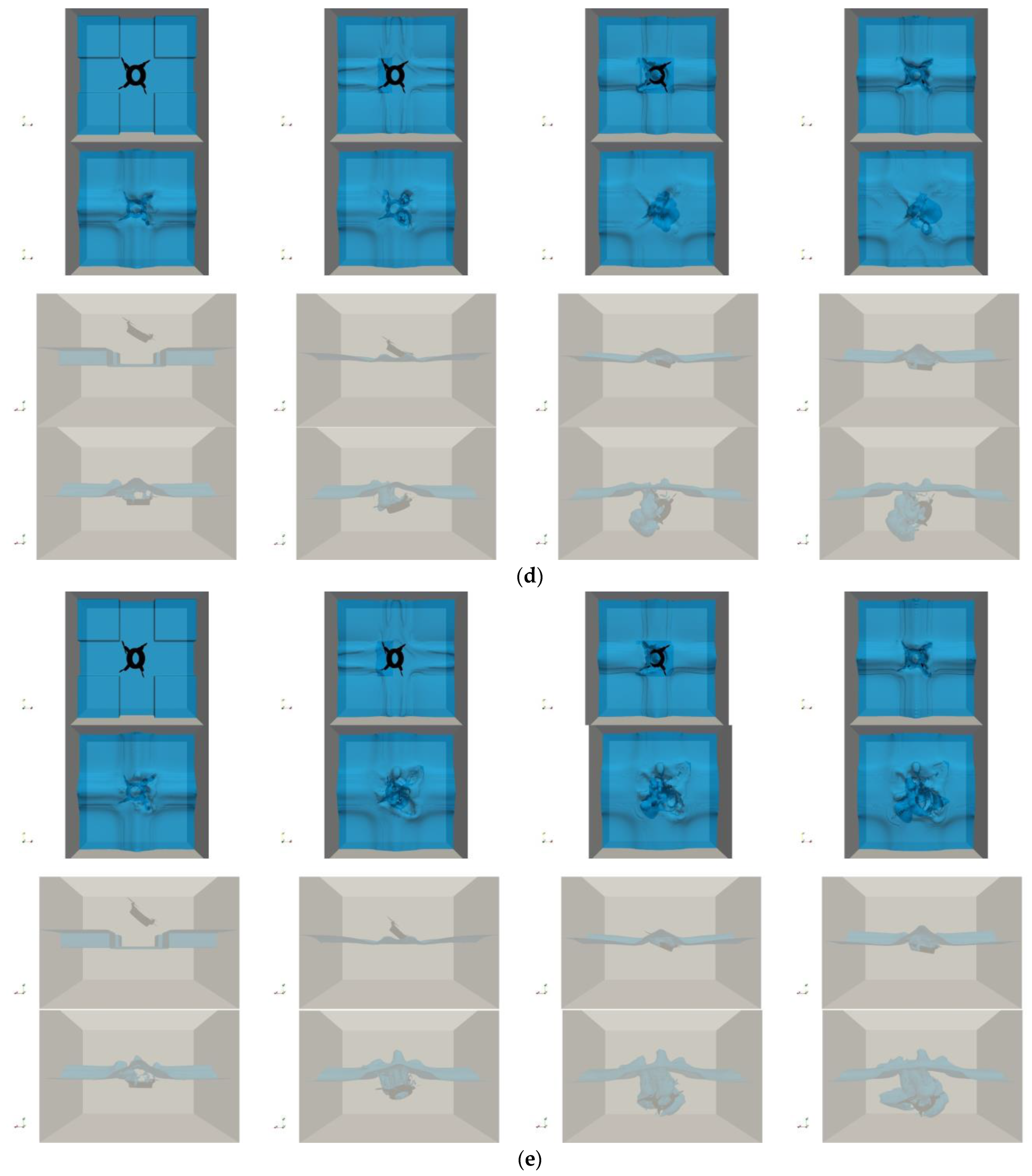
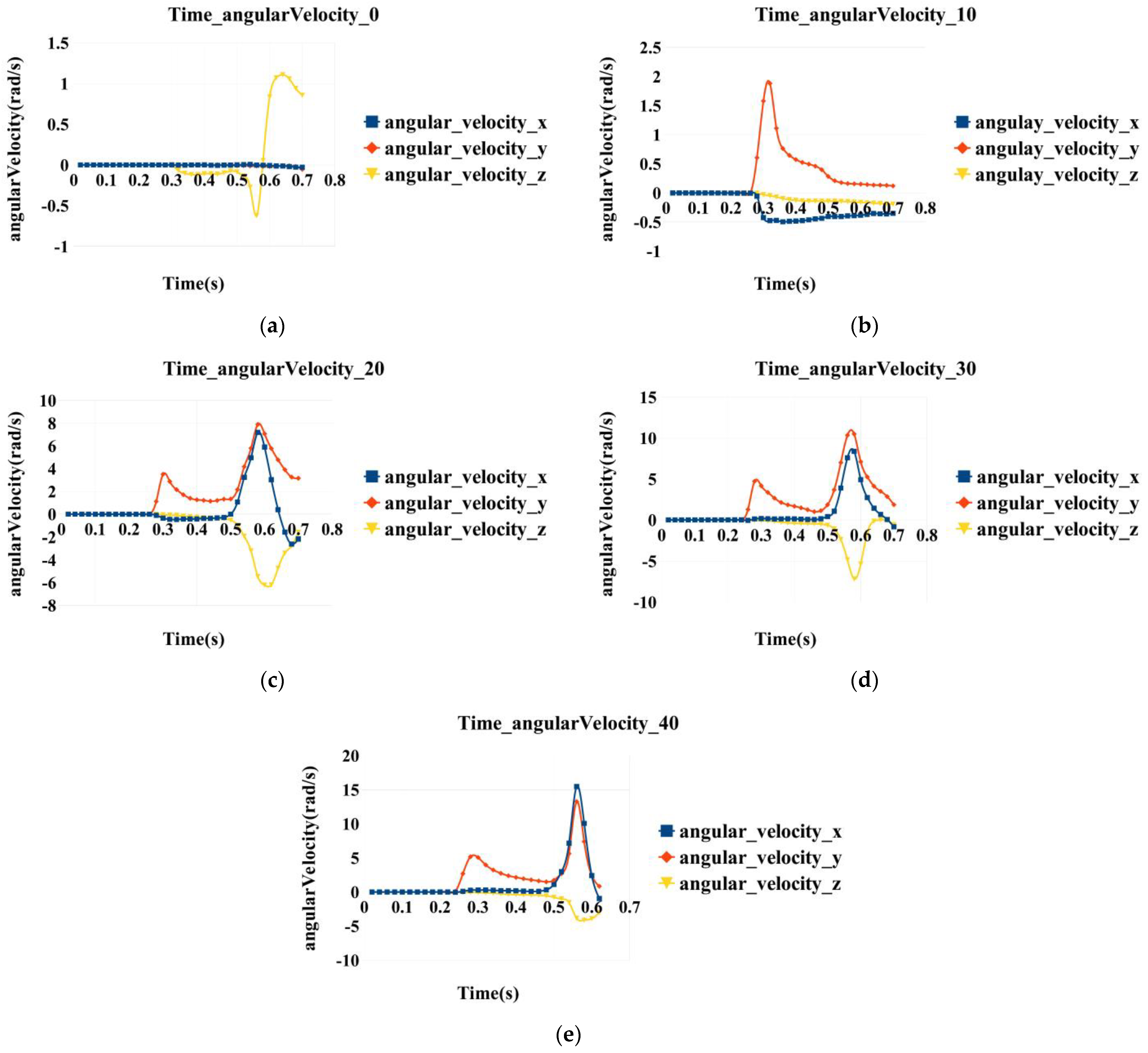
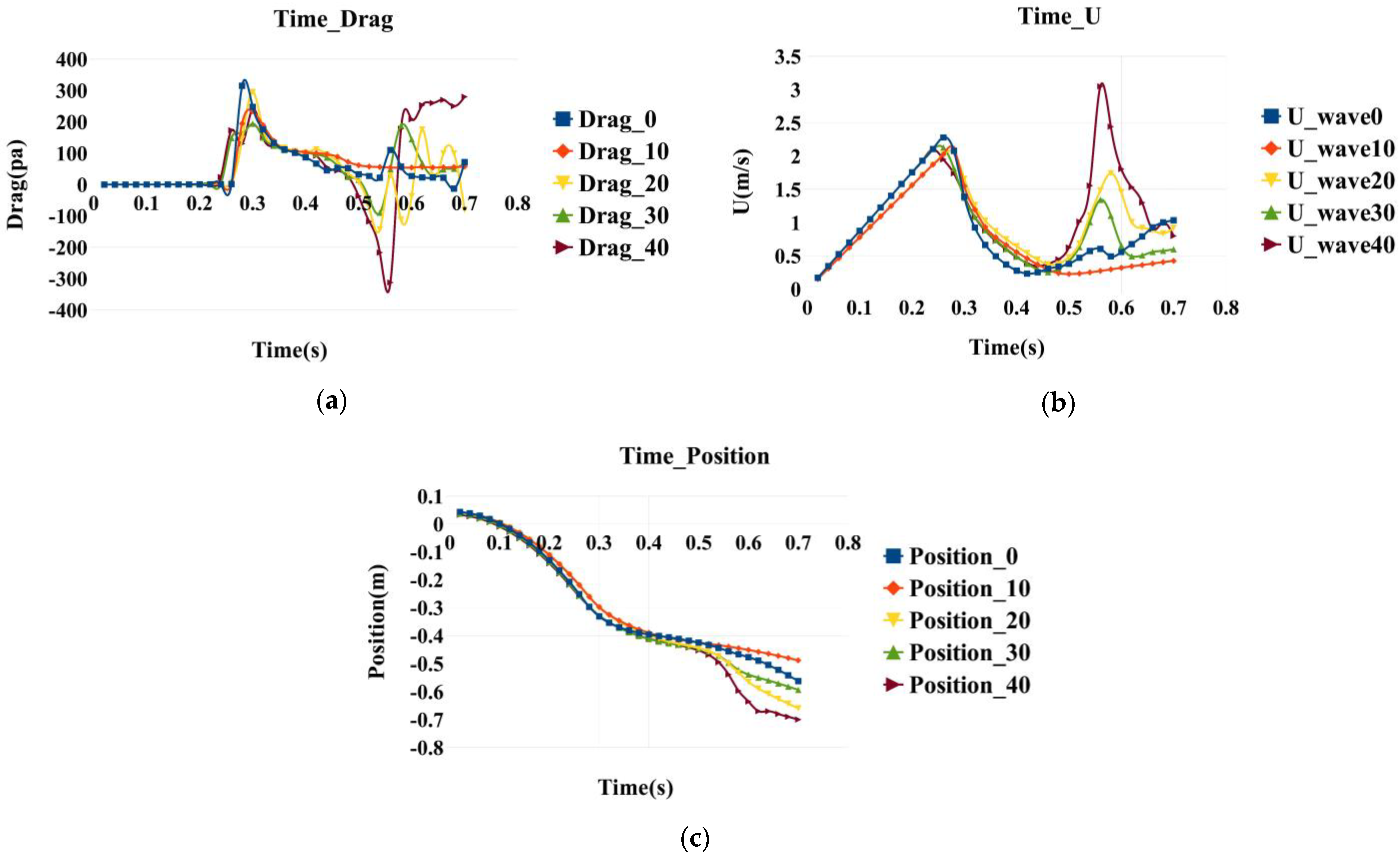
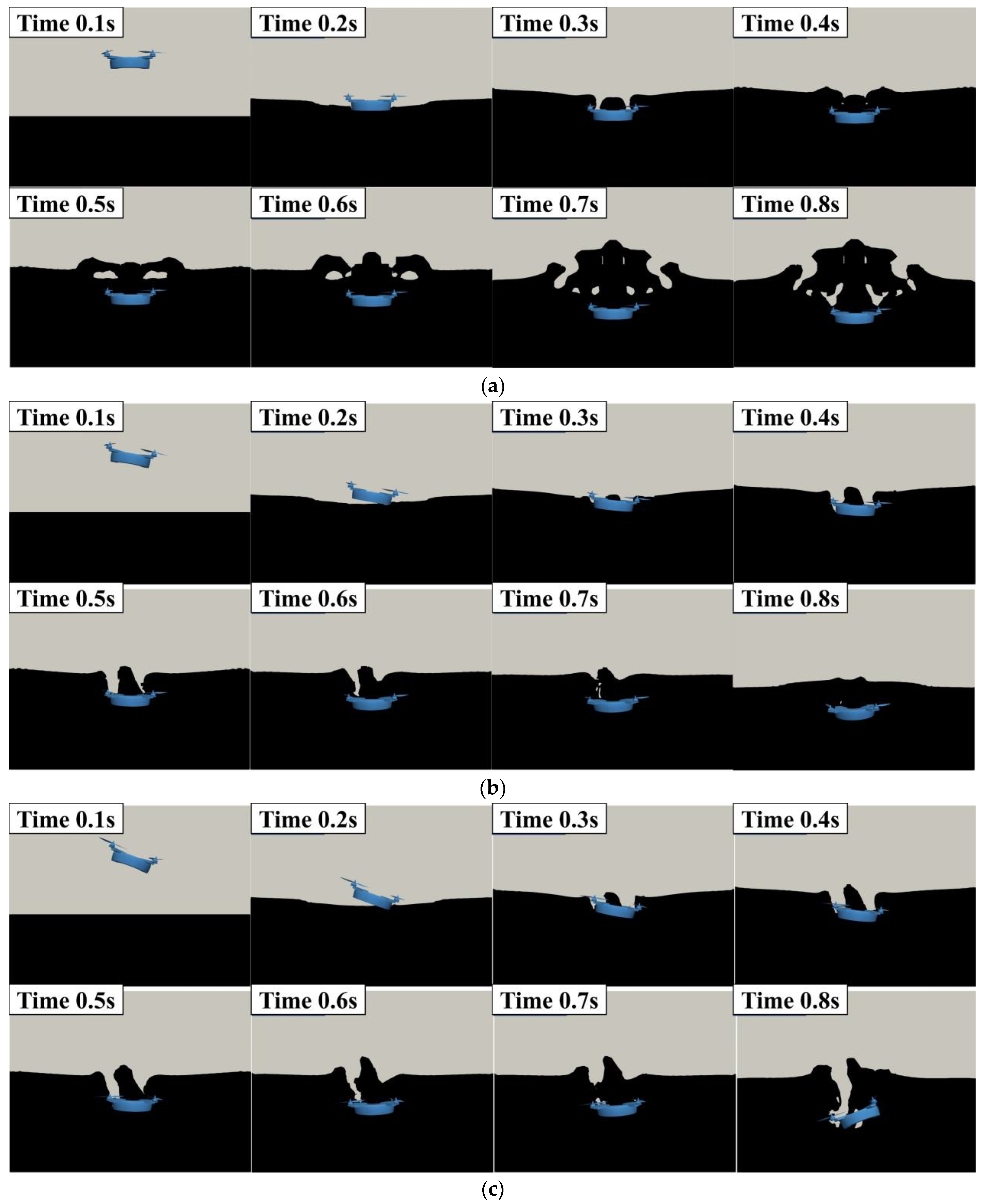
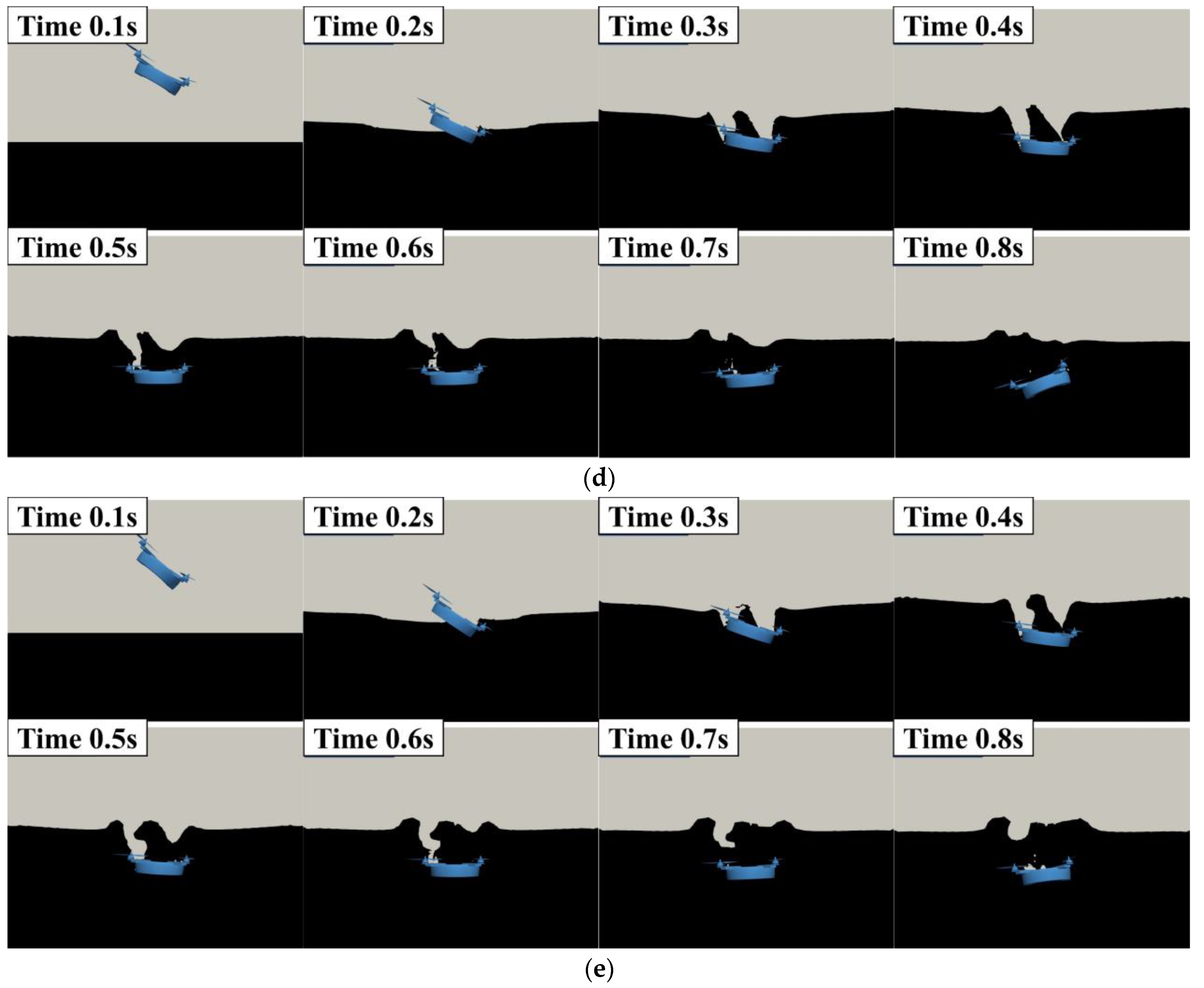

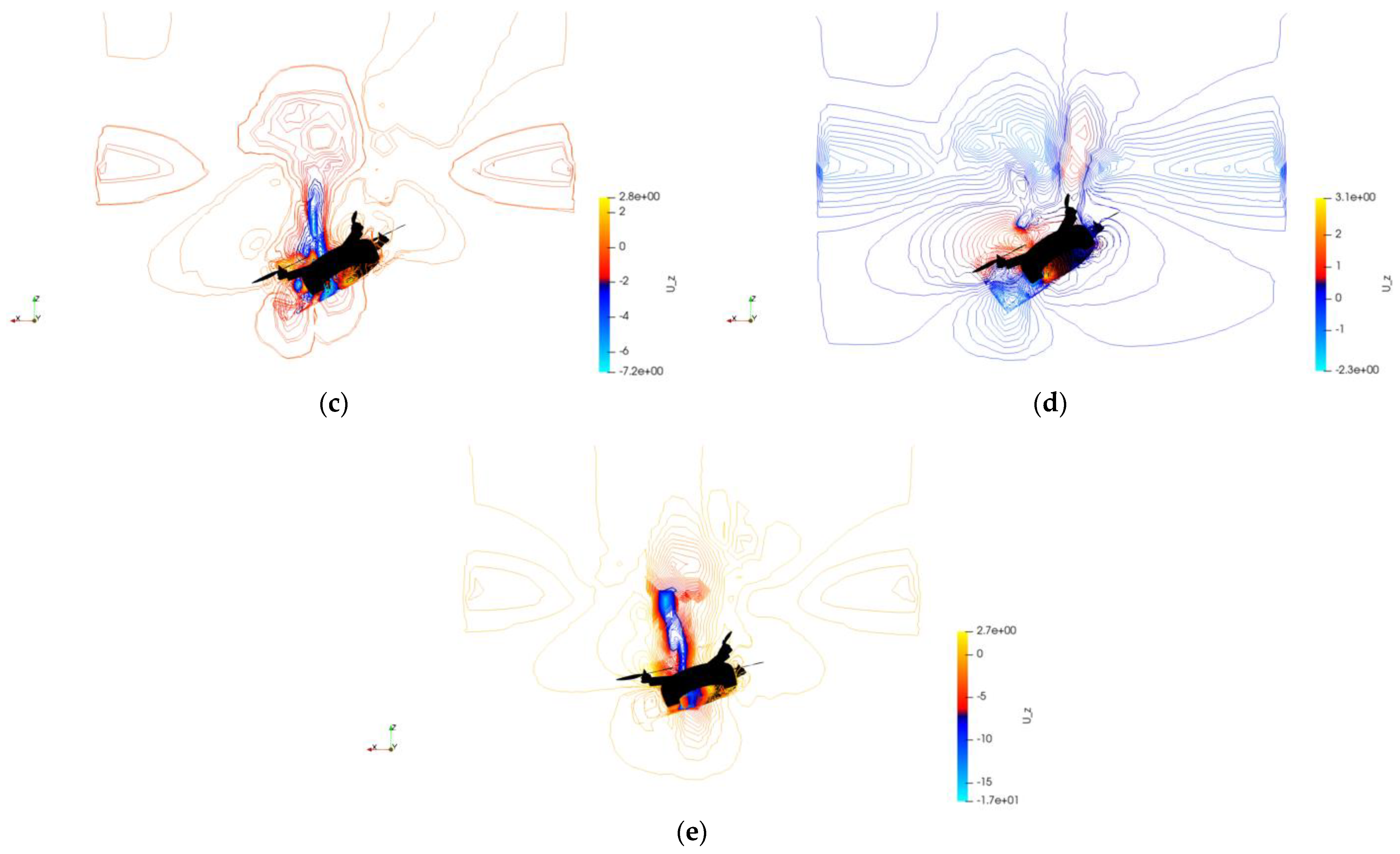
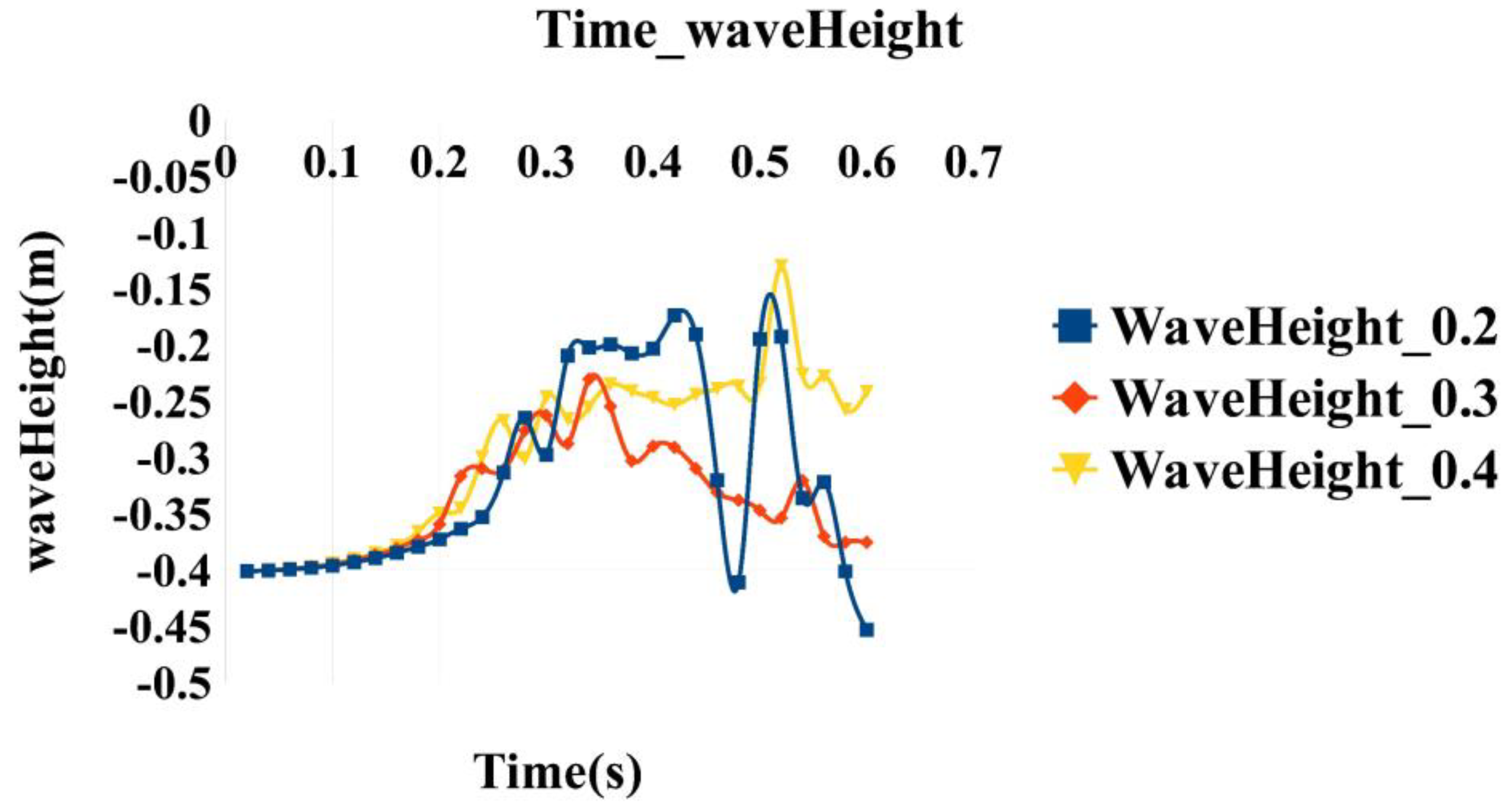
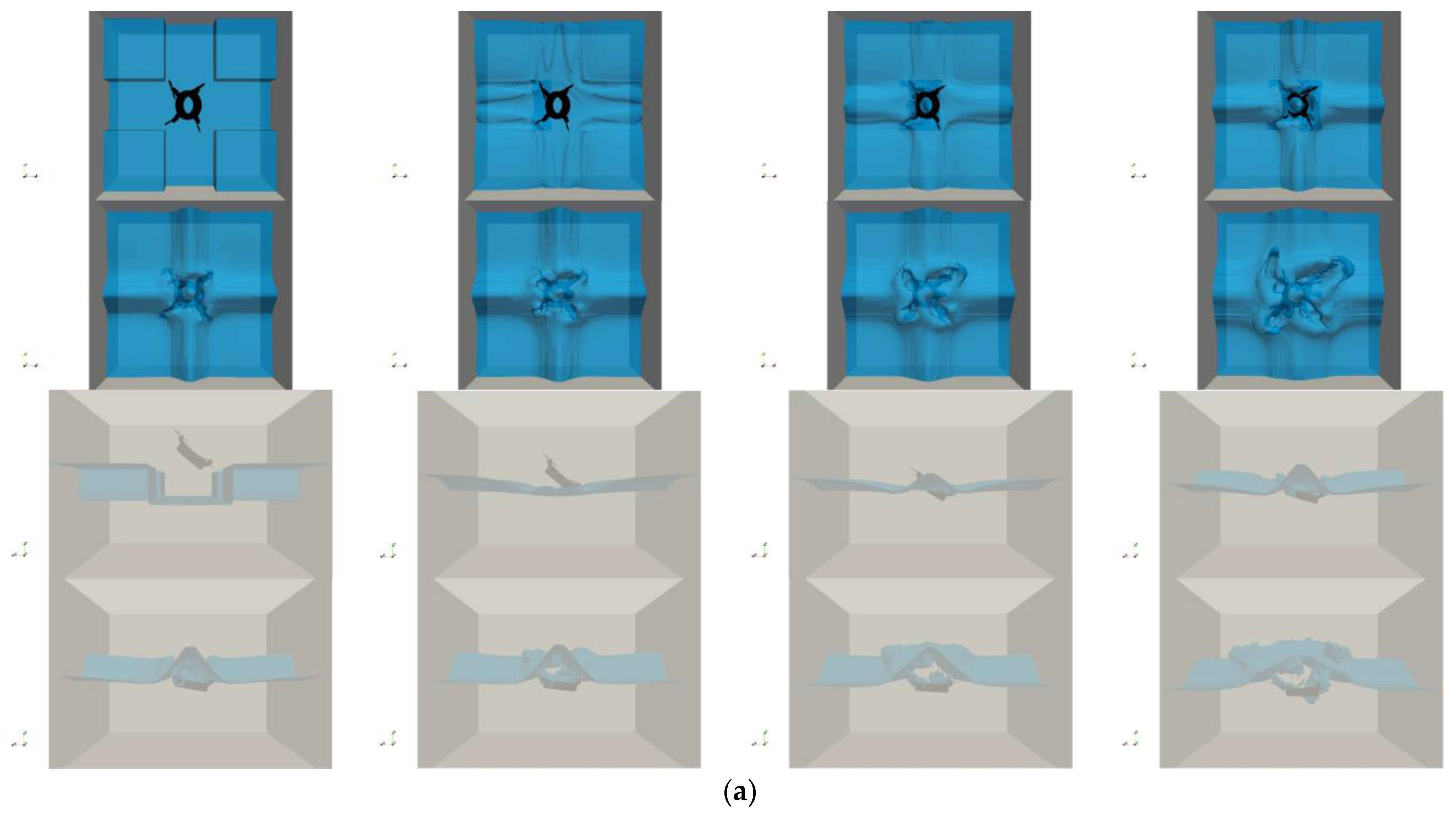
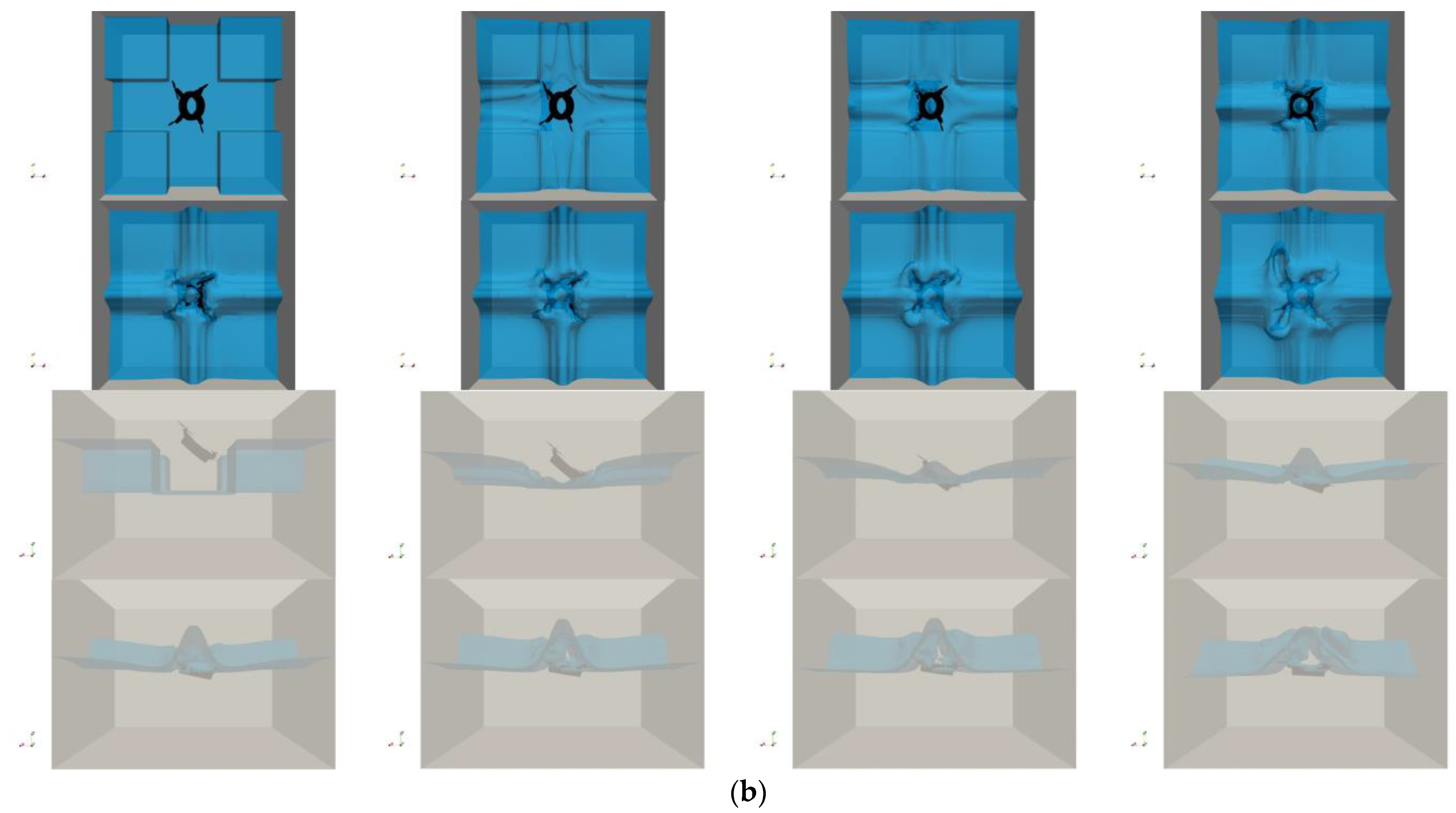


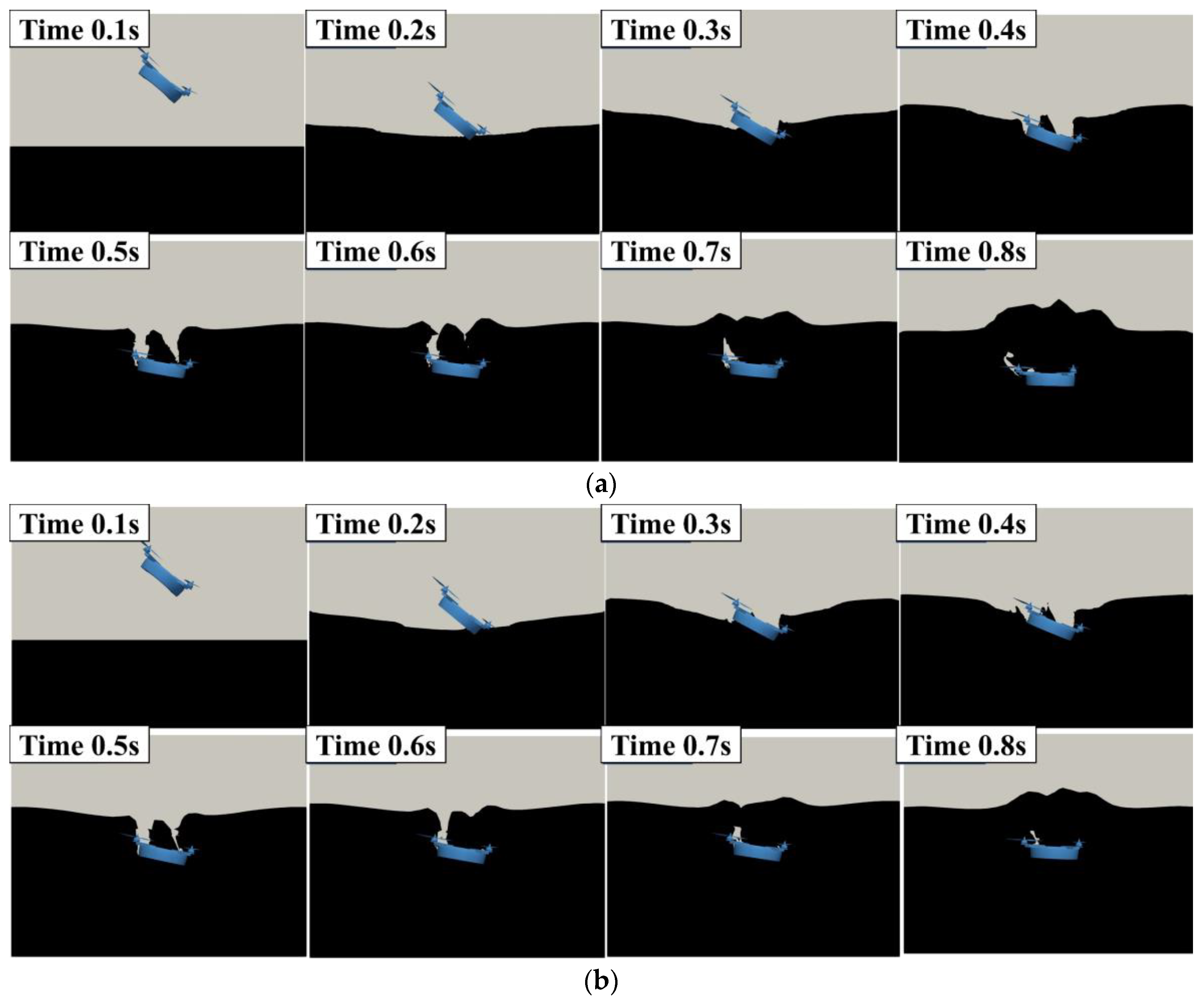
| Mesh Type | Number of Grid Cells | Grid Base Size/m | |
|---|---|---|---|
| Background Area | Overlapping Area | ||
| coarse | 1,554,953 | 0.13 | 0.06 |
| medium | 3,663,283 | 0.10 | 0.05 |
| fine | 4,437,138 | 0.07 | 0.04 |
| Turbulence Parameters | Inlet | Outlet | Wall | Blades |
|---|---|---|---|---|
| k | fixedValue | inletOutlet | kqRWallFunction | kqRWallFunction |
| nut | calculated | calculated | nutUSpaldingWallFunction | nutUSpaldingWallFunction |
| omega | fixedValue | inletOutlet | omegaWallFunction | omegaWallFunction |
| p | fixedFluxPressure | totalPressure | fixedFluxPressure | fixedFluxPressure |
| U | fixedValue | pressureInletOutletVelocity | fixedValue | movingWallVelocity |
| Mesh Type | Turbulence Model | Physical Time Step | Maximum y+ Value | Whether to Use Wall Functions | Solving Time |
|---|---|---|---|---|---|
| coarse | k-omega two-equation model | s | 40 | YES | 0.88 h (64 CPUs) |
| medium | k-omega two-equation model | s | 35 | YES | 2.07 h (64 CPUs) |
| fine | k-omega two-equation model | s | 32 | YES | 2.54 h (64 CPUs) |
Disclaimer/Publisher’s Note: The statements, opinions and data contained in all publications are solely those of the individual author(s) and contributor(s) and not of MDPI and/or the editor(s). MDPI and/or the editor(s) disclaim responsibility for any injury to people or property resulting from any ideas, methods, instructions or products referred to in the content. |
© 2023 by the authors. Licensee MDPI, Basel, Switzerland. This article is an open access article distributed under the terms and conditions of the Creative Commons Attribution (CC BY) license (https://creativecommons.org/licenses/by/4.0/).
Share and Cite
Wei, J.; Sha, Y.-B.; Hu, X.-Y.; Cao, Z.; Chen, D.-P.; Zhou, D.; Chen, Y.-L. Research on Aerodynamic Characteristics of Trans-Media Vehicles Entering and Exiting the Water in Still Water and Wave Environments. Drones 2023, 7, 69. https://doi.org/10.3390/drones7020069
Wei J, Sha Y-B, Hu X-Y, Cao Z, Chen D-P, Zhou D, Chen Y-L. Research on Aerodynamic Characteristics of Trans-Media Vehicles Entering and Exiting the Water in Still Water and Wave Environments. Drones. 2023; 7(2):69. https://doi.org/10.3390/drones7020069
Chicago/Turabian StyleWei, Jun, Yong-Bai Sha, Xin-Yu Hu, Zhe Cao, De-Ping Chen, Da Zhou, and Yan-Li Chen. 2023. "Research on Aerodynamic Characteristics of Trans-Media Vehicles Entering and Exiting the Water in Still Water and Wave Environments" Drones 7, no. 2: 69. https://doi.org/10.3390/drones7020069
APA StyleWei, J., Sha, Y.-B., Hu, X.-Y., Cao, Z., Chen, D.-P., Zhou, D., & Chen, Y.-L. (2023). Research on Aerodynamic Characteristics of Trans-Media Vehicles Entering and Exiting the Water in Still Water and Wave Environments. Drones, 7(2), 69. https://doi.org/10.3390/drones7020069








